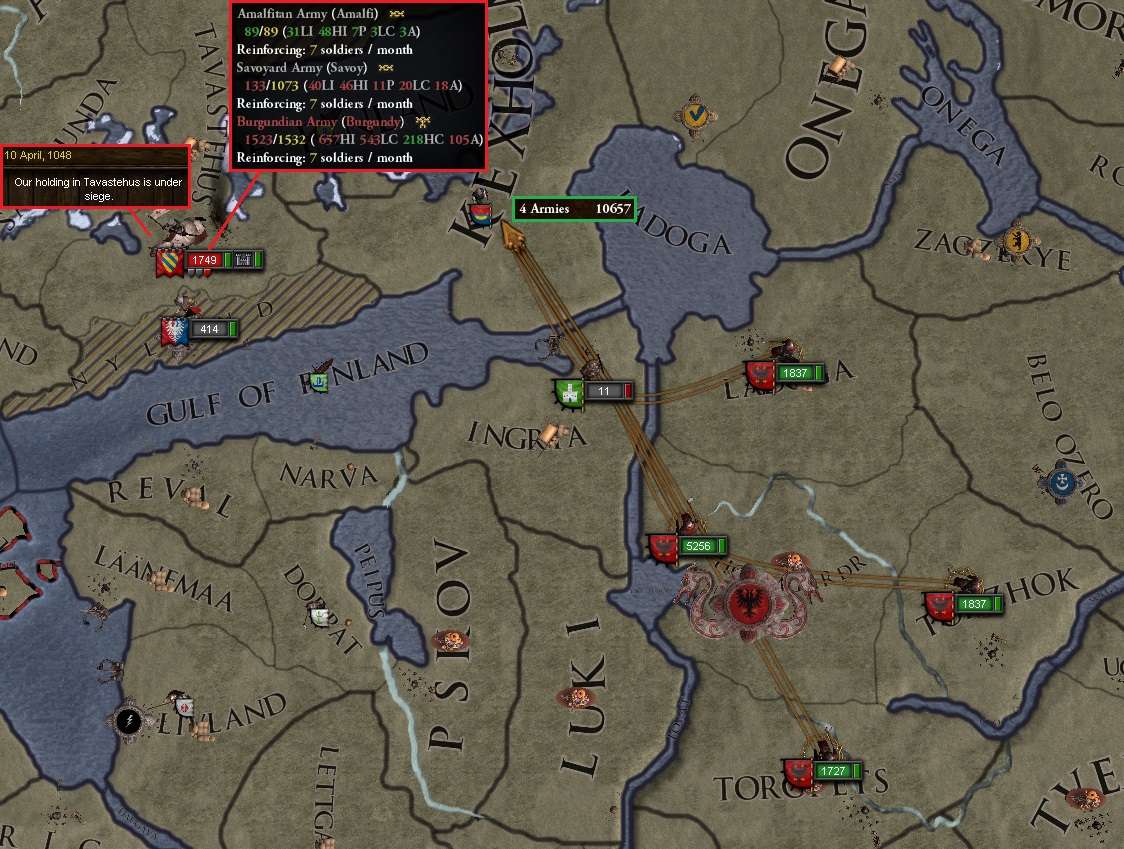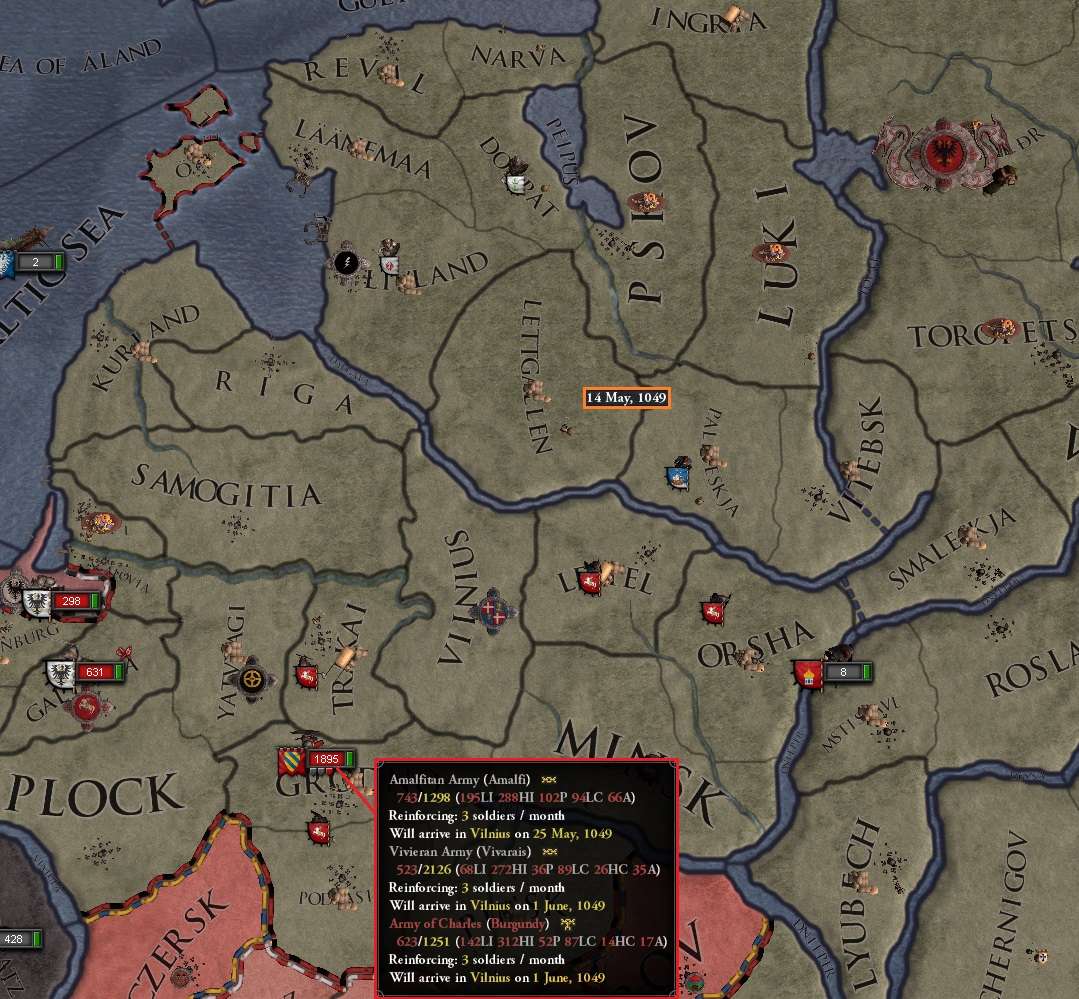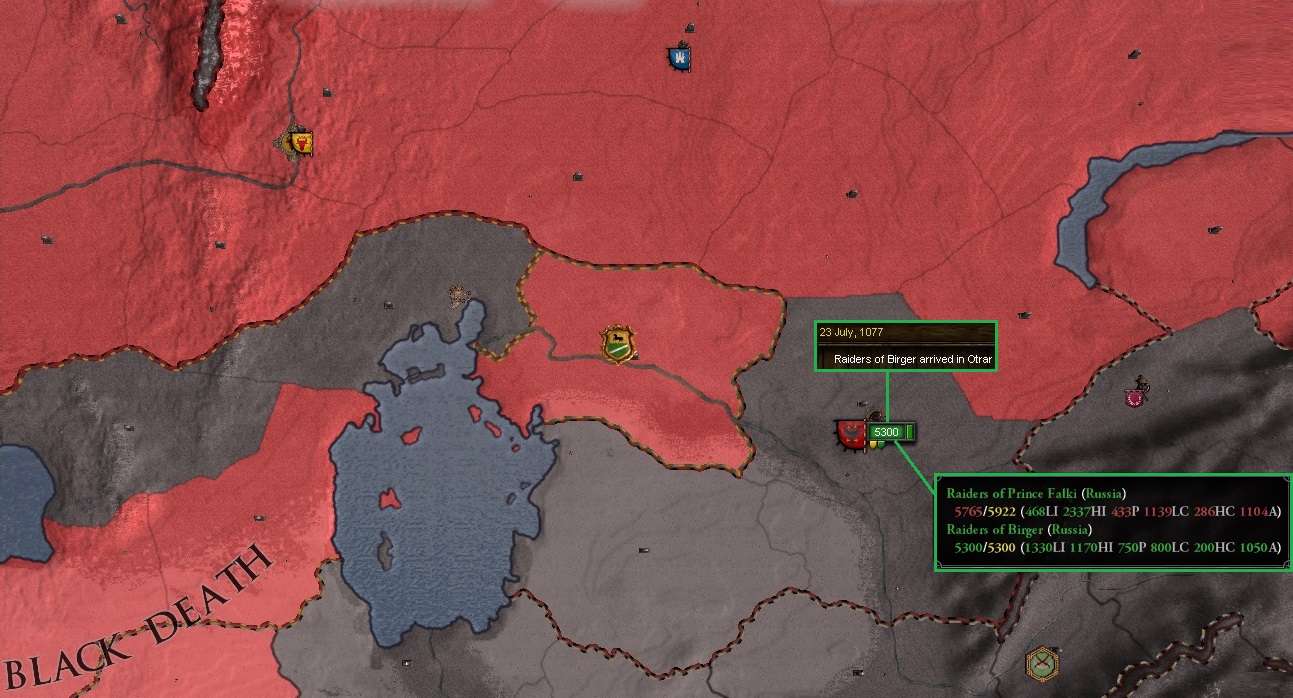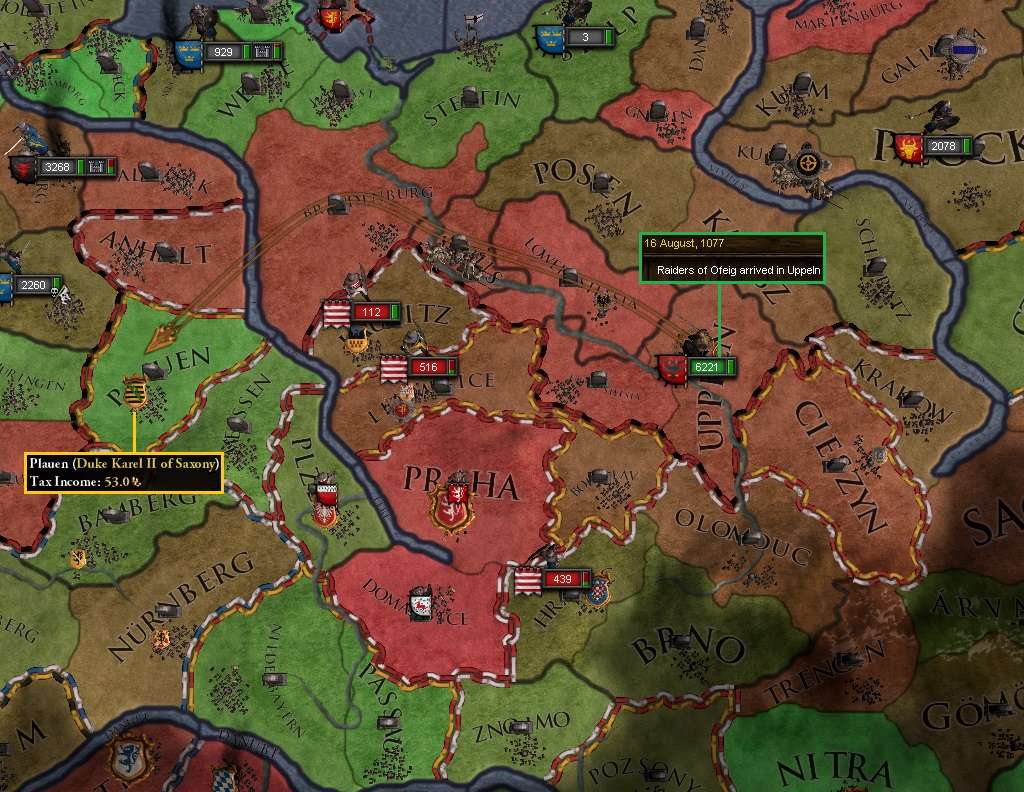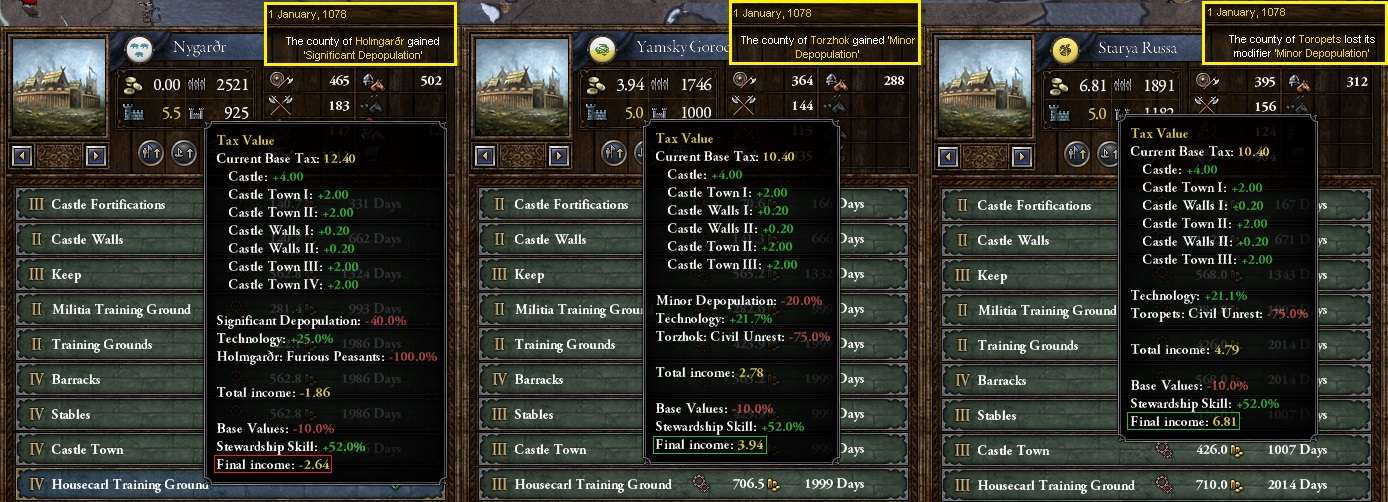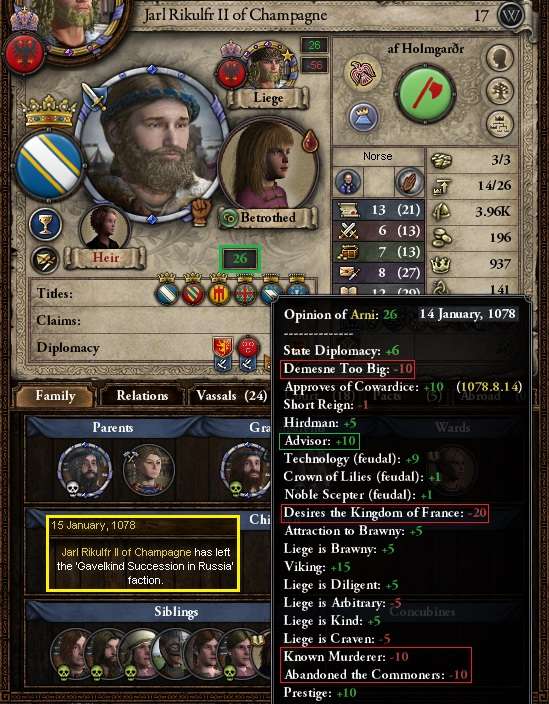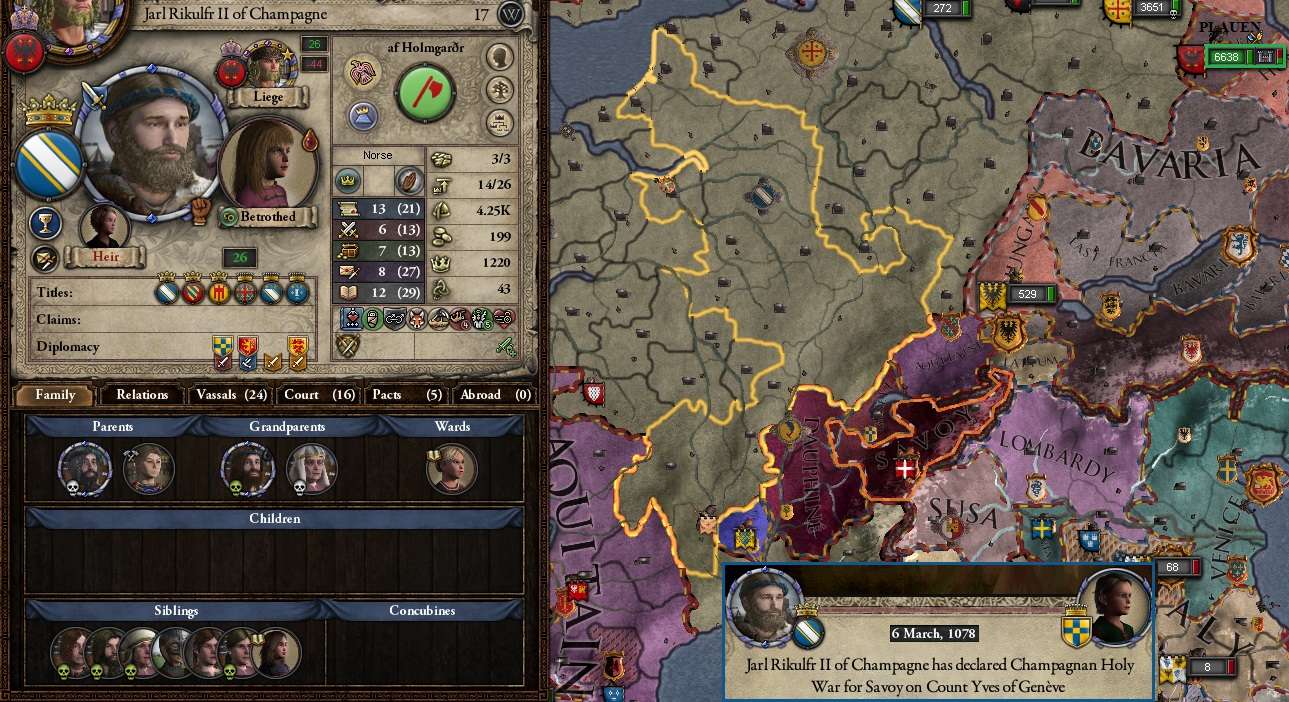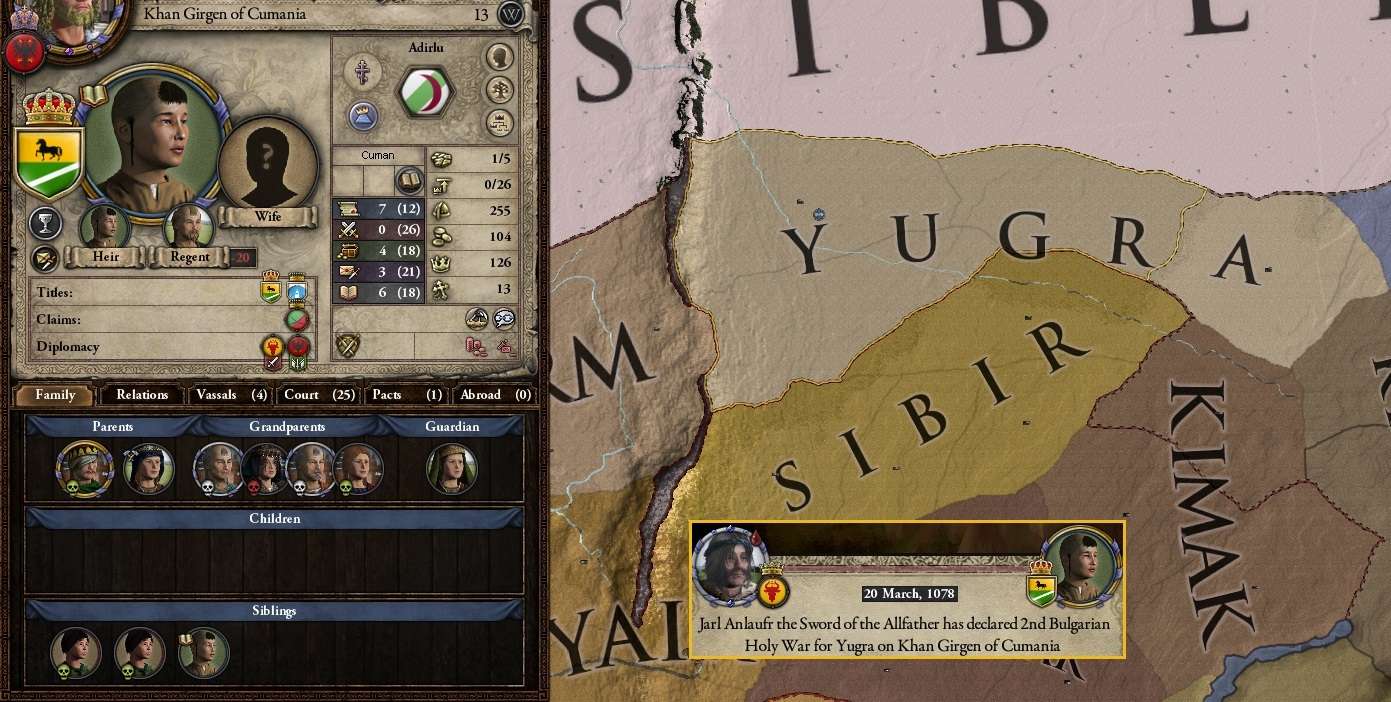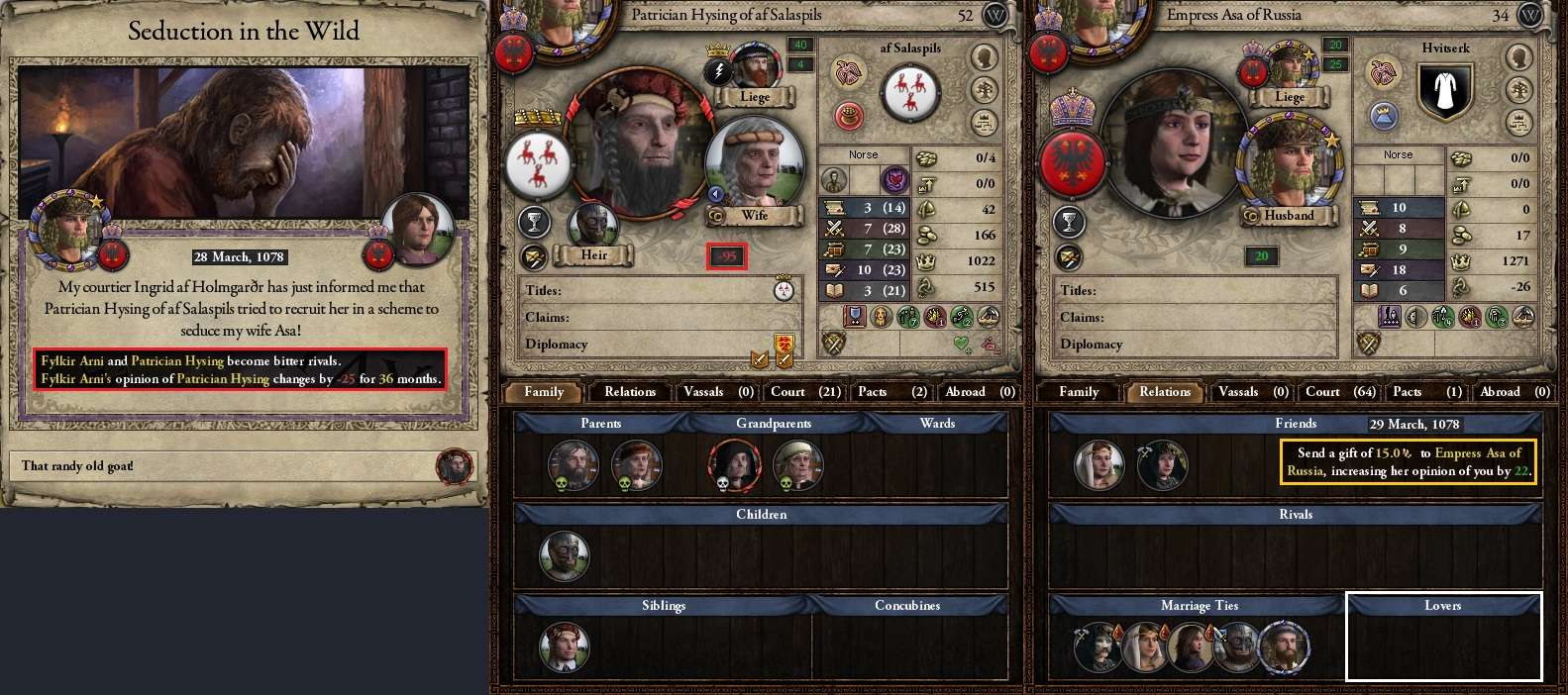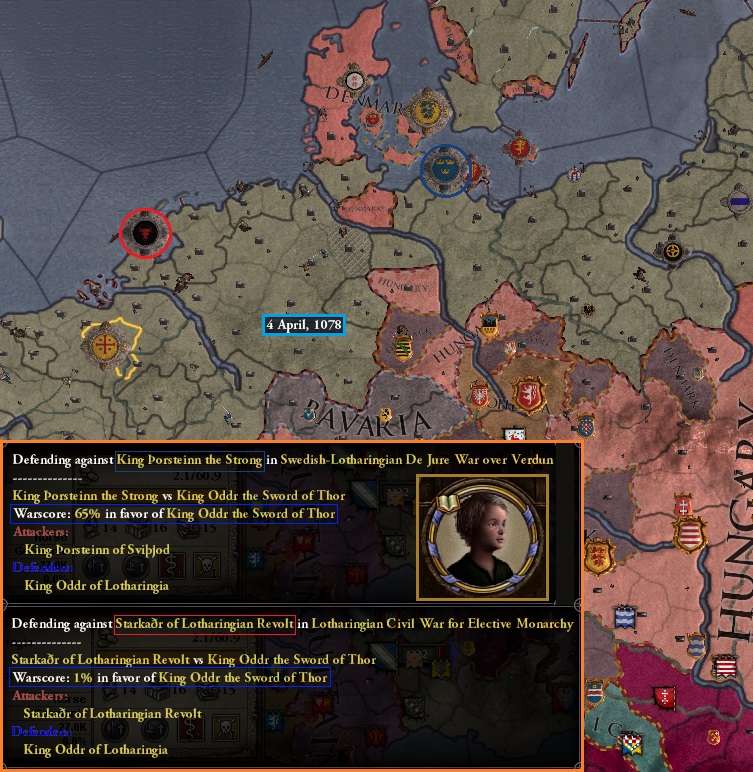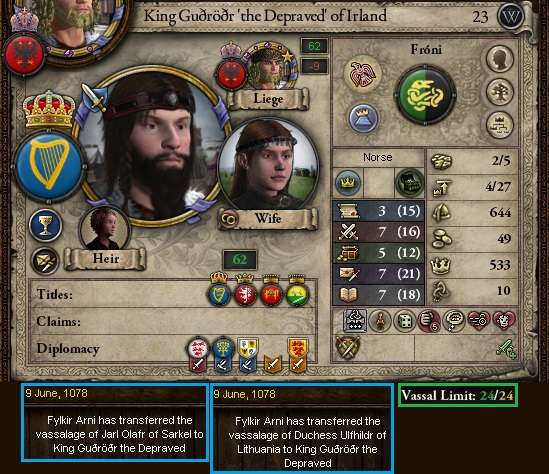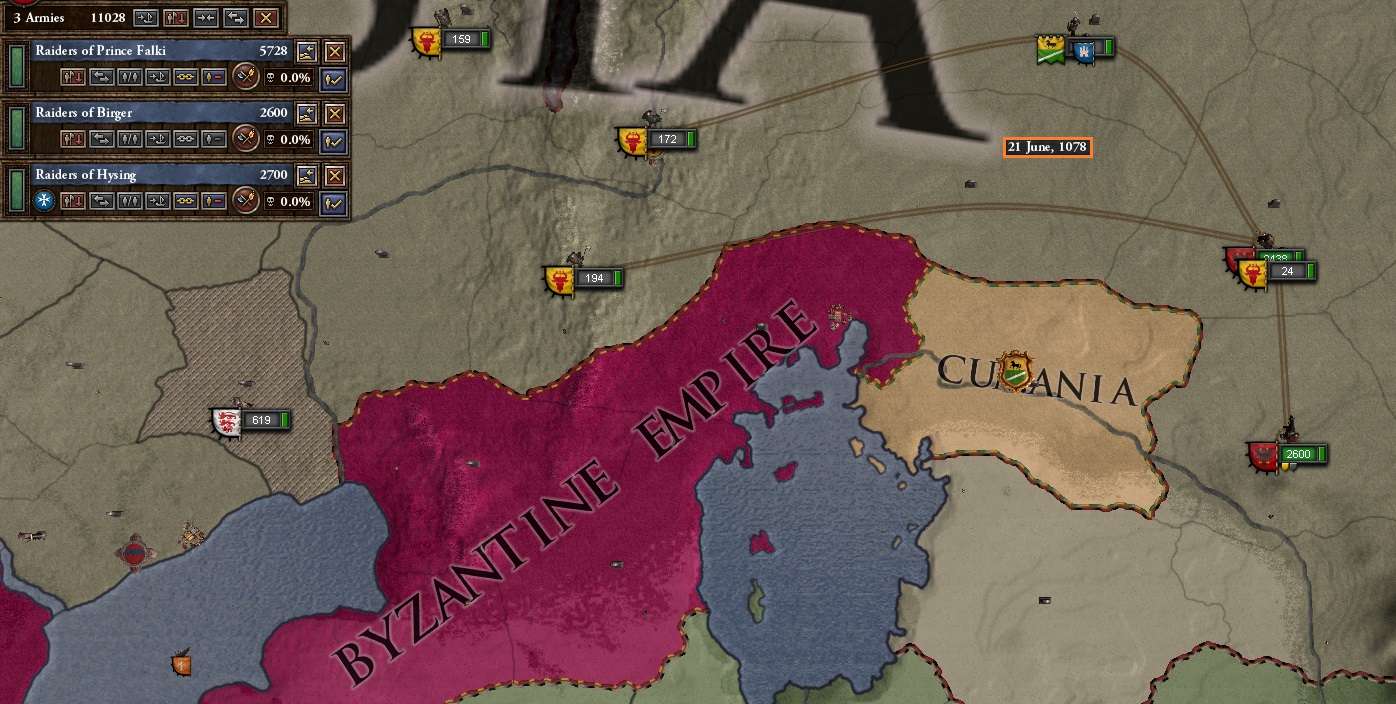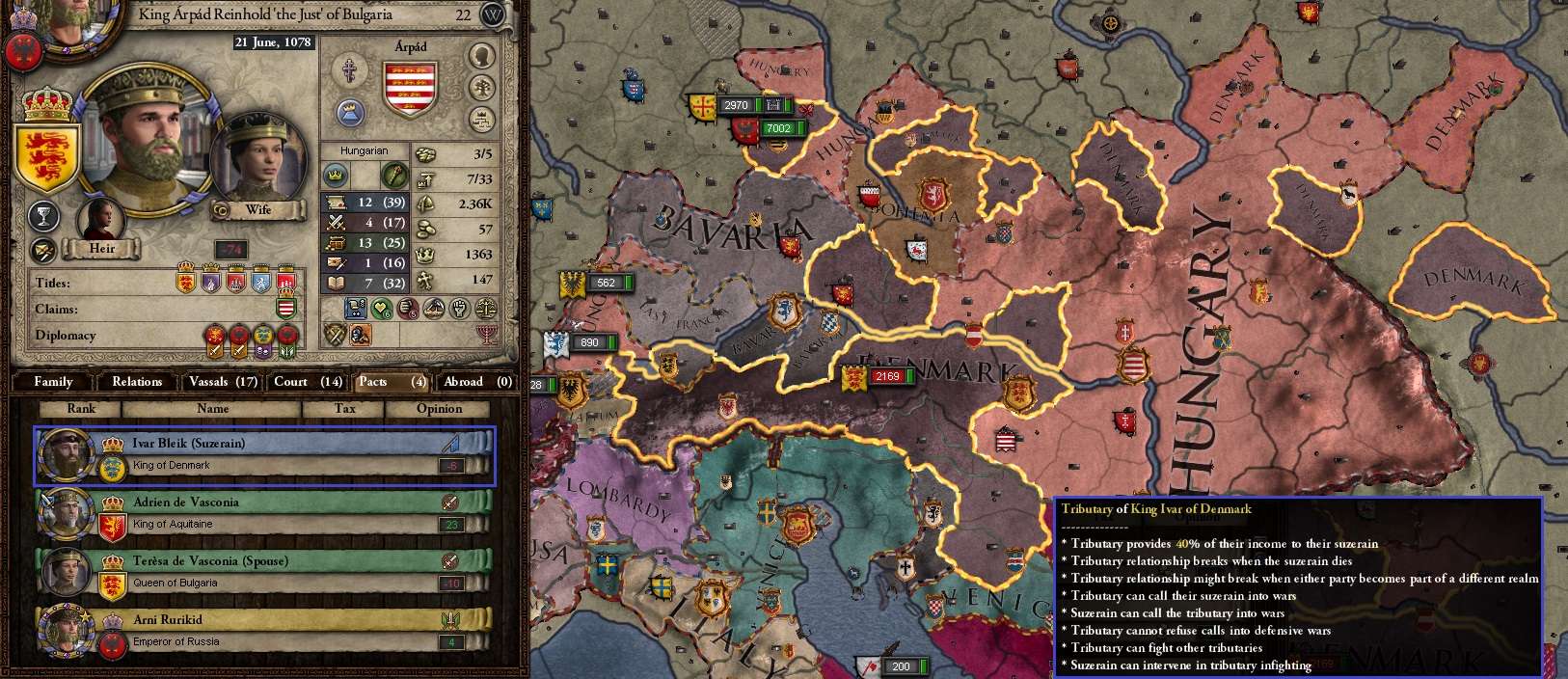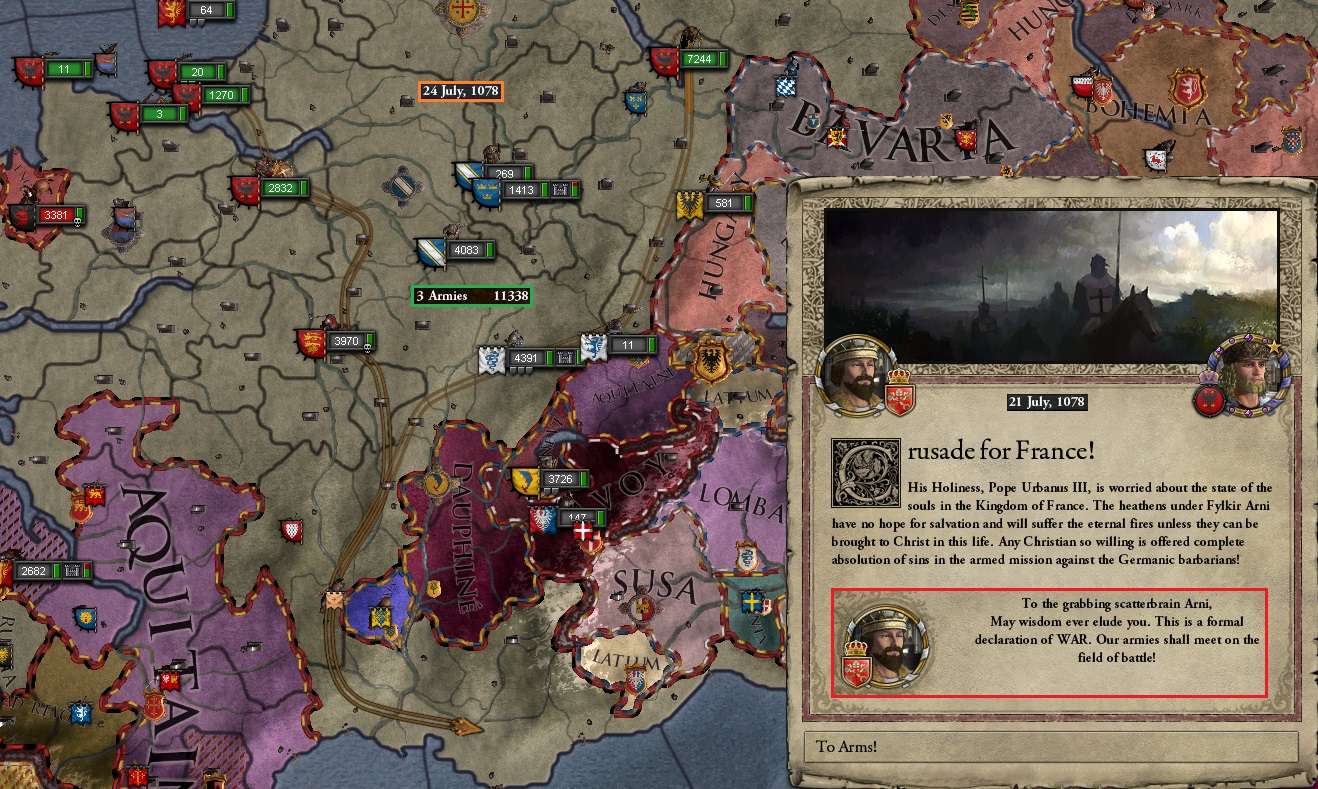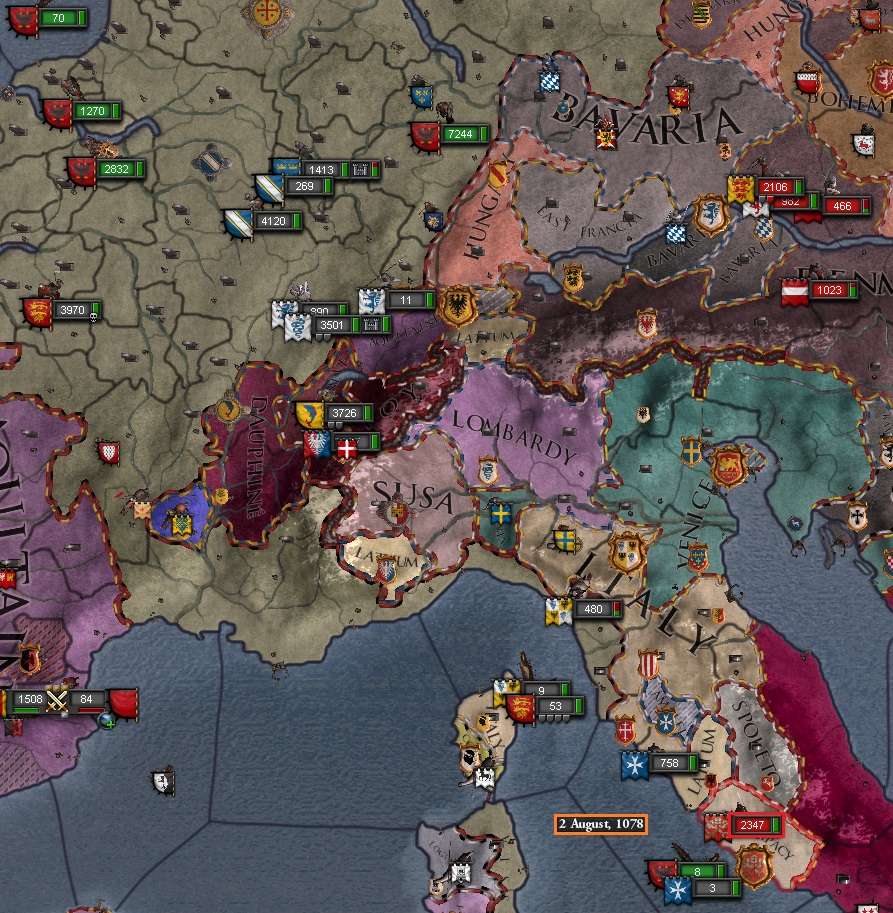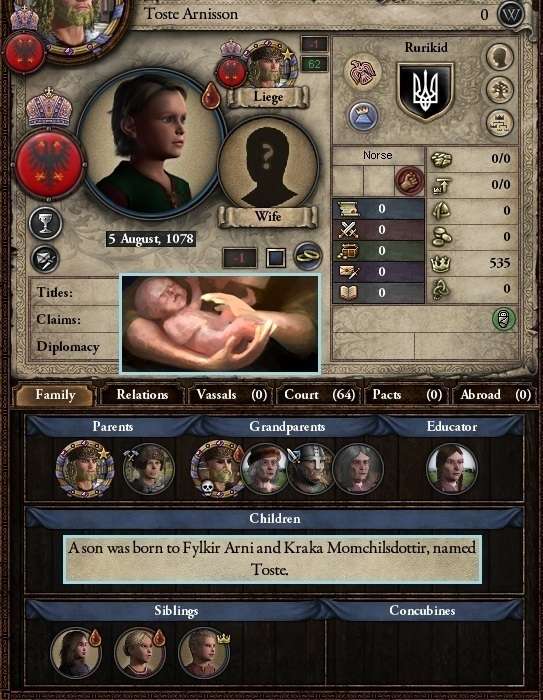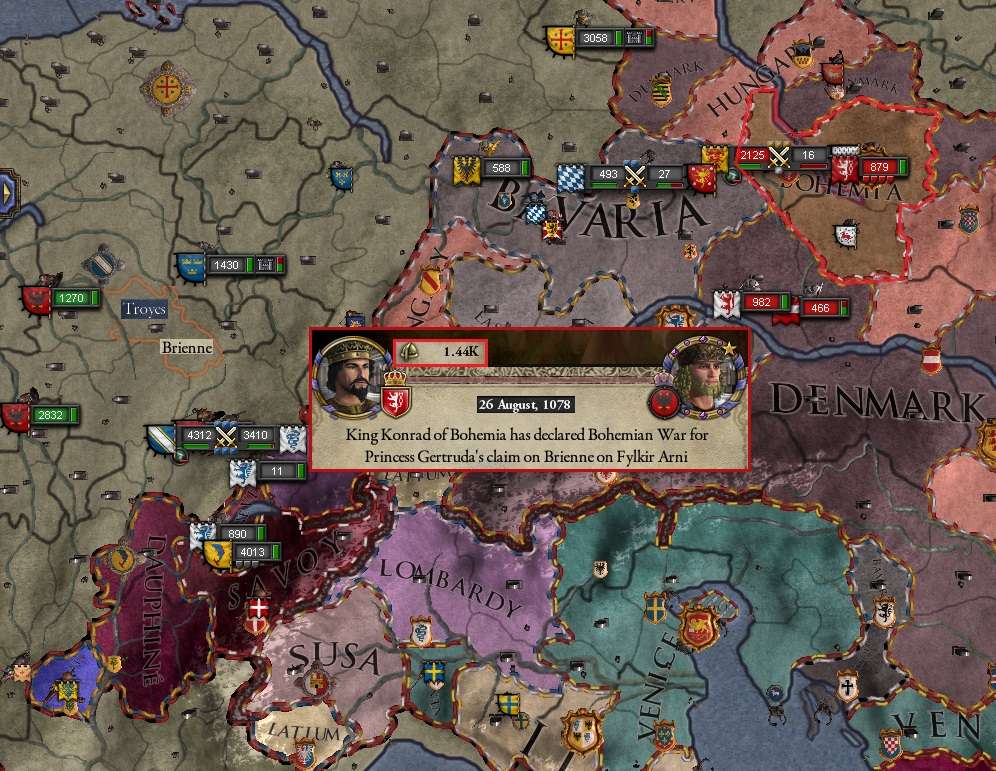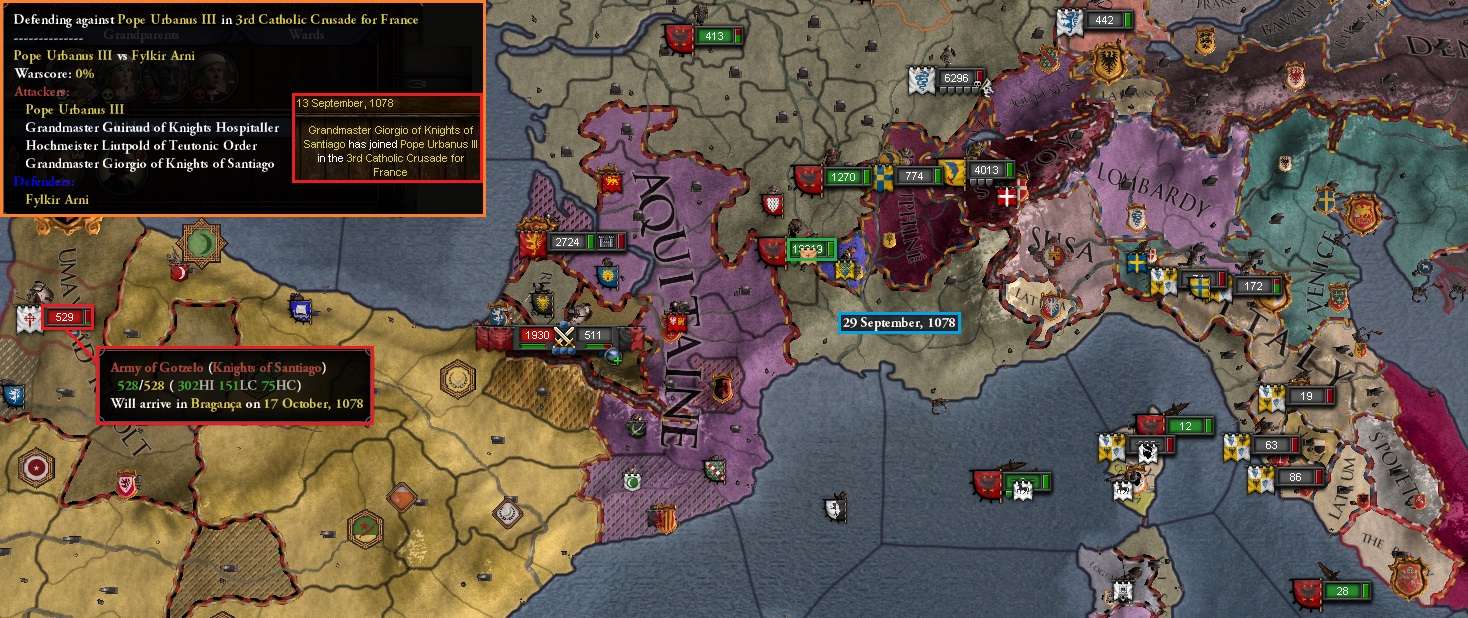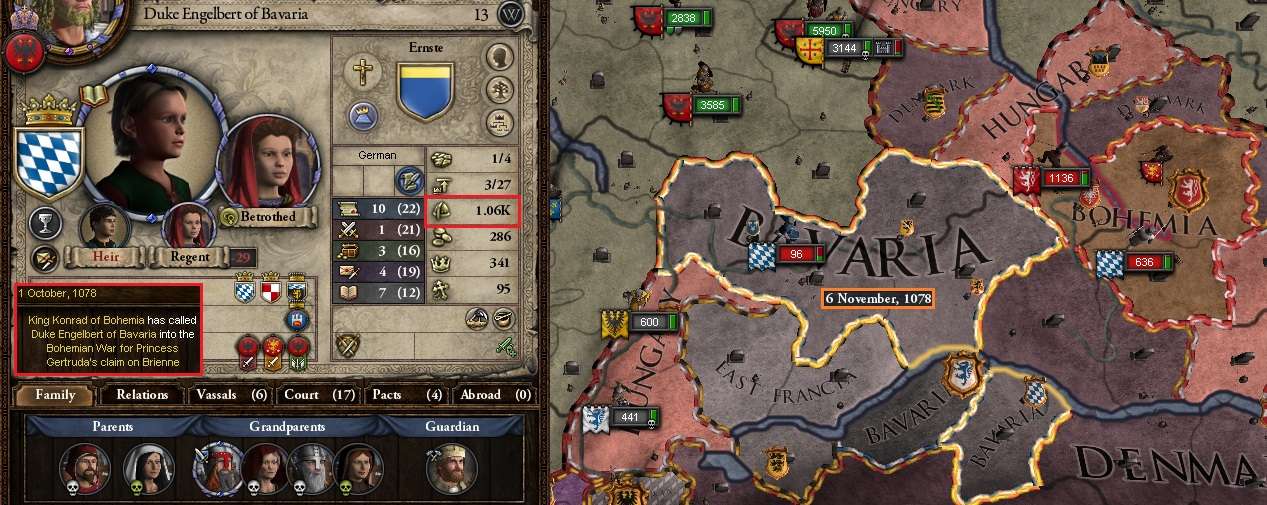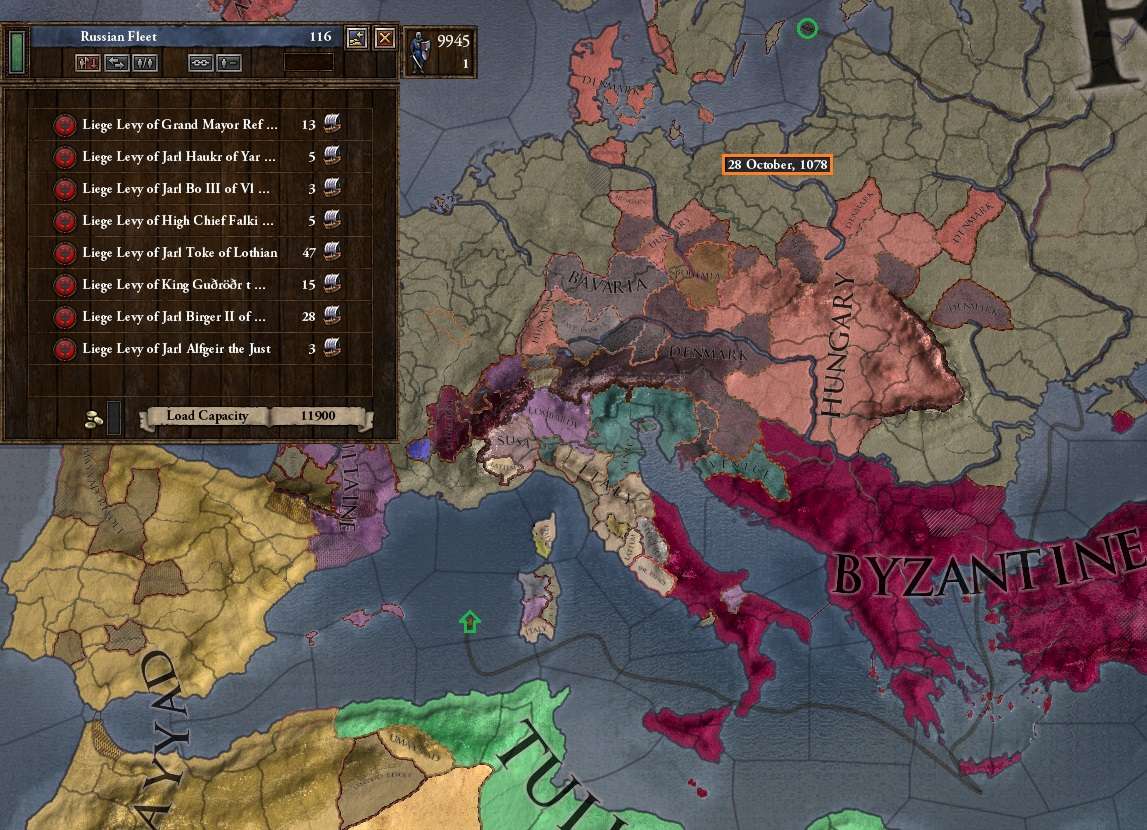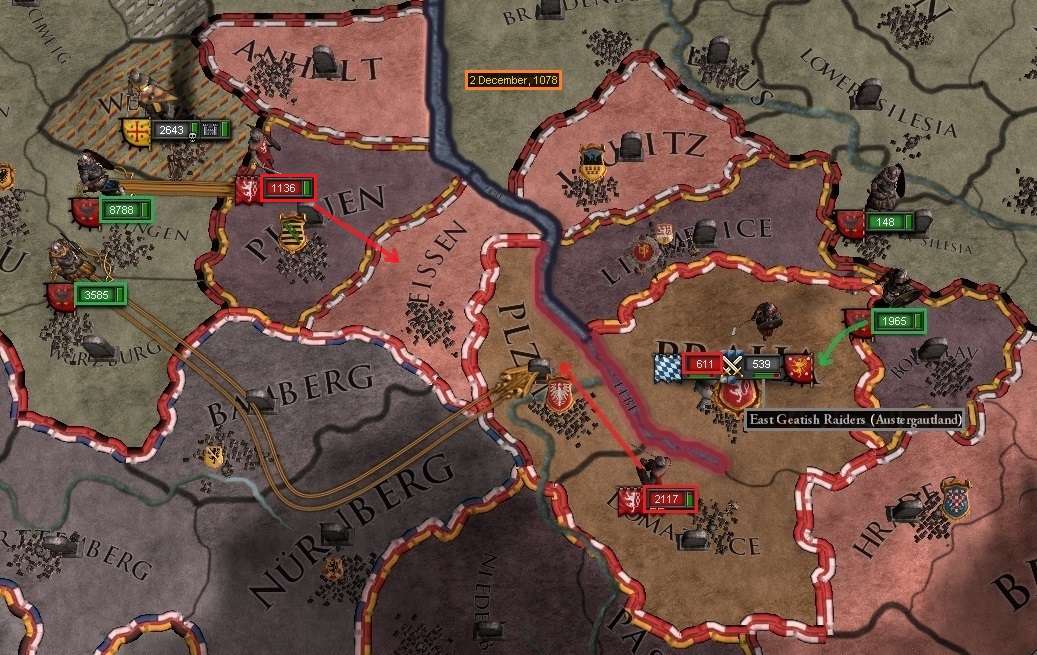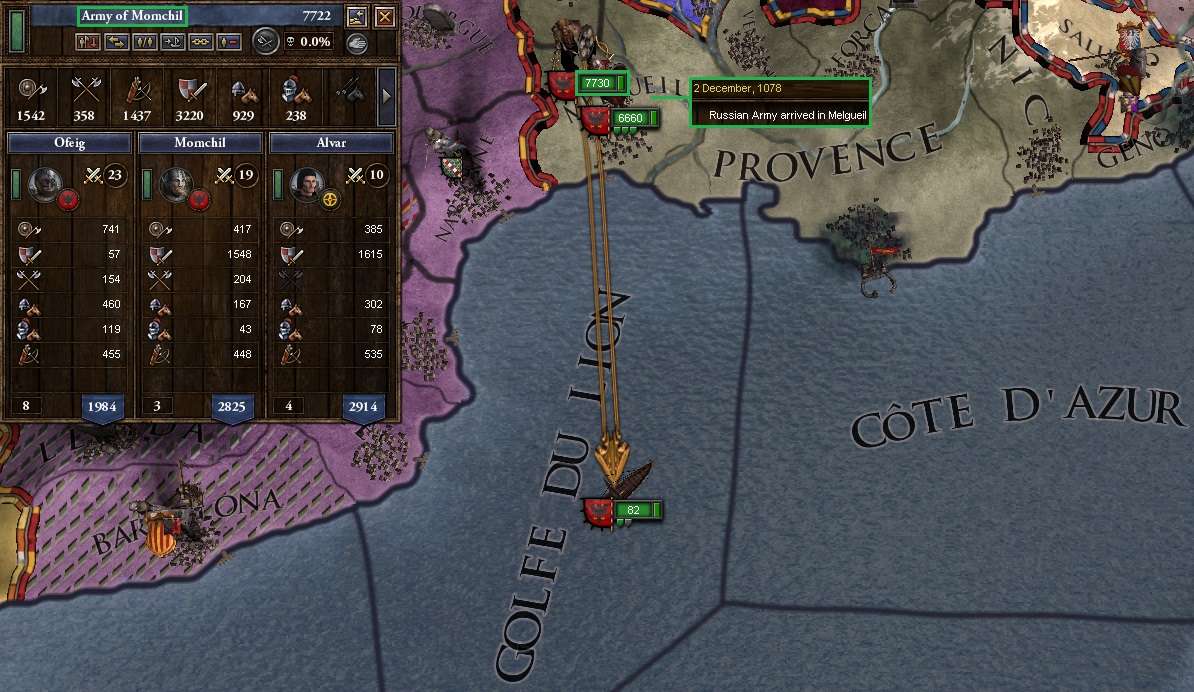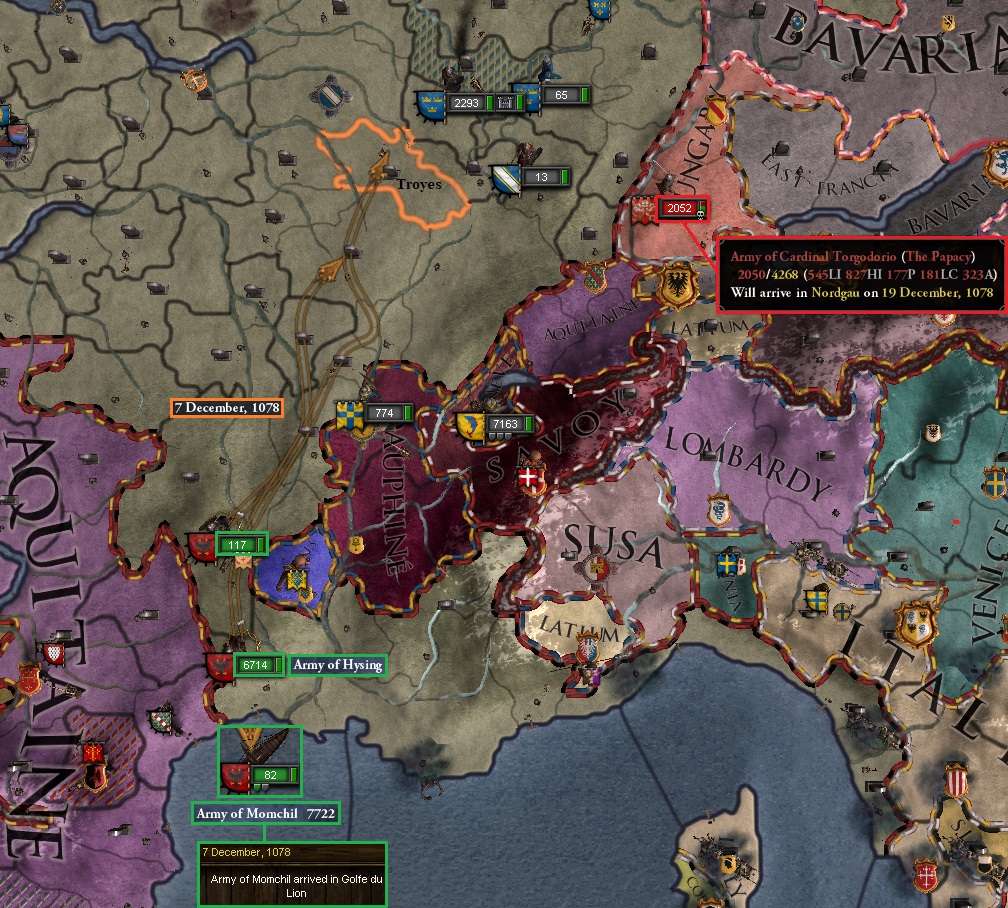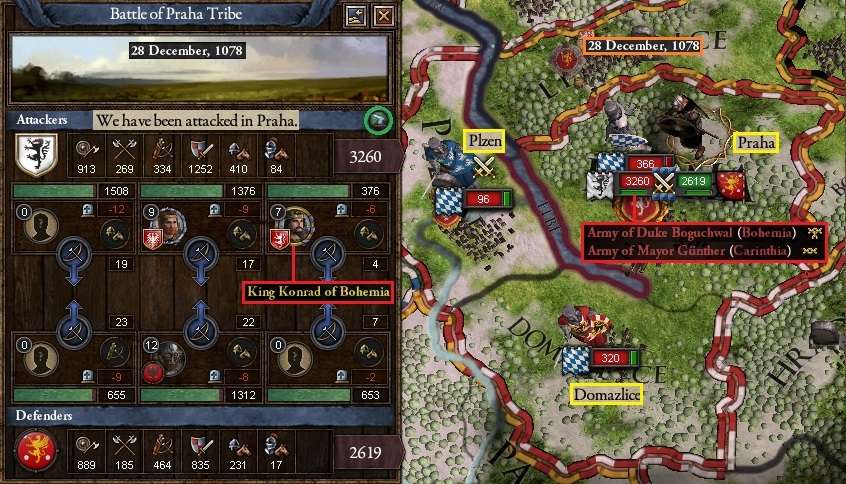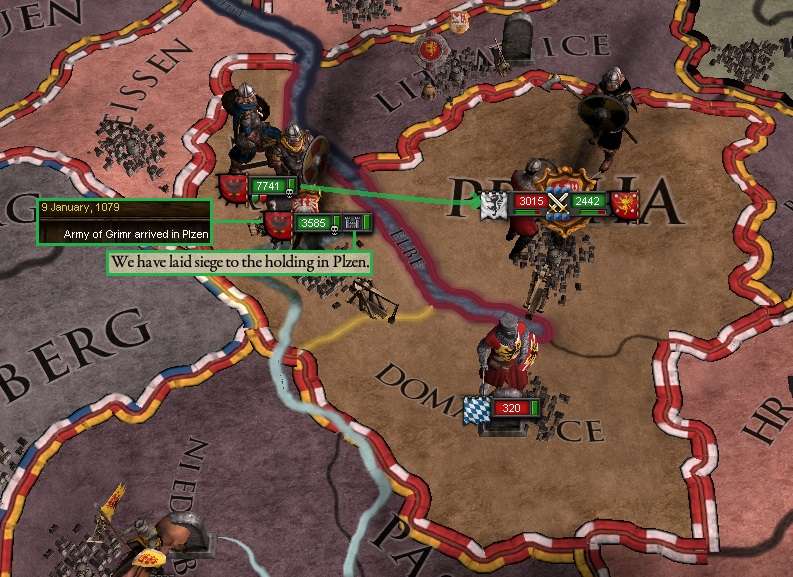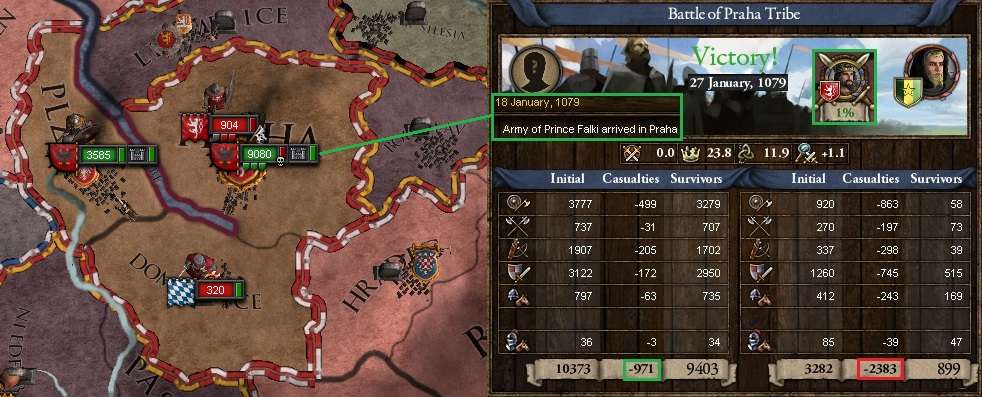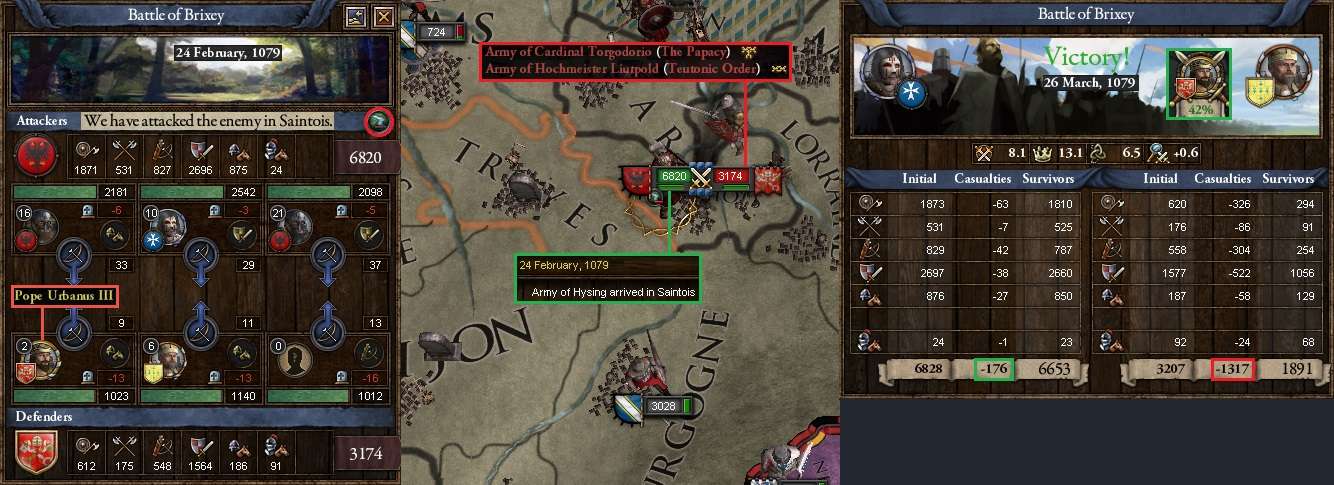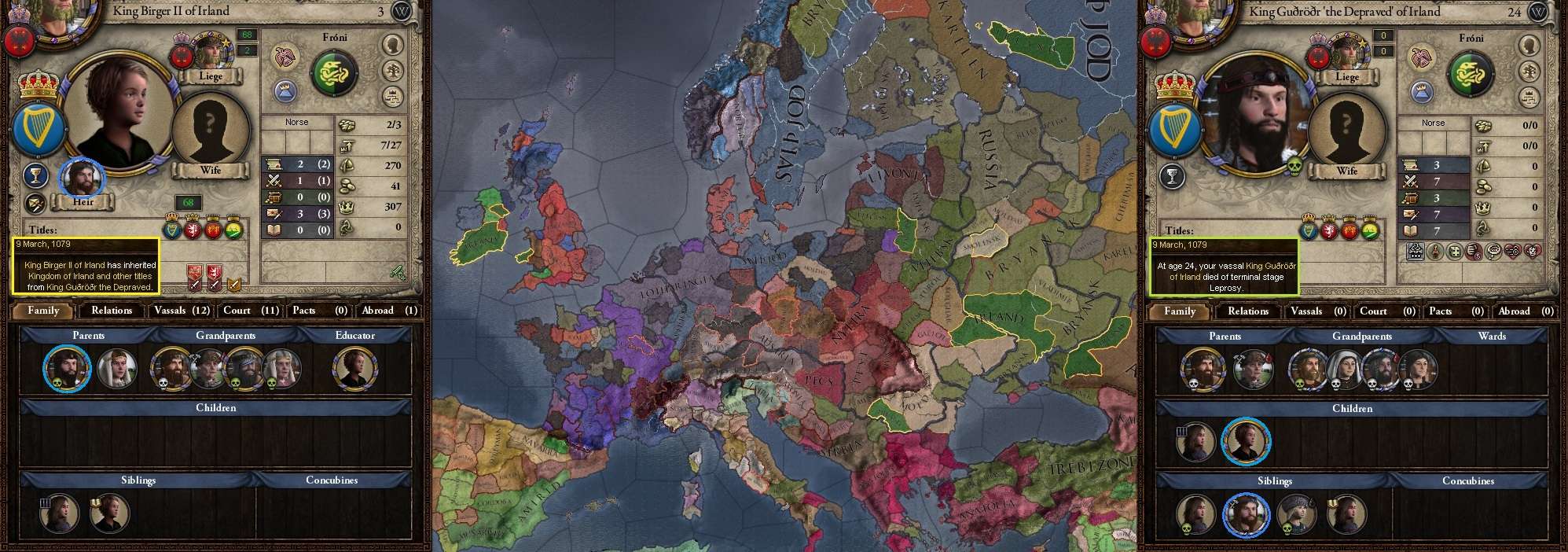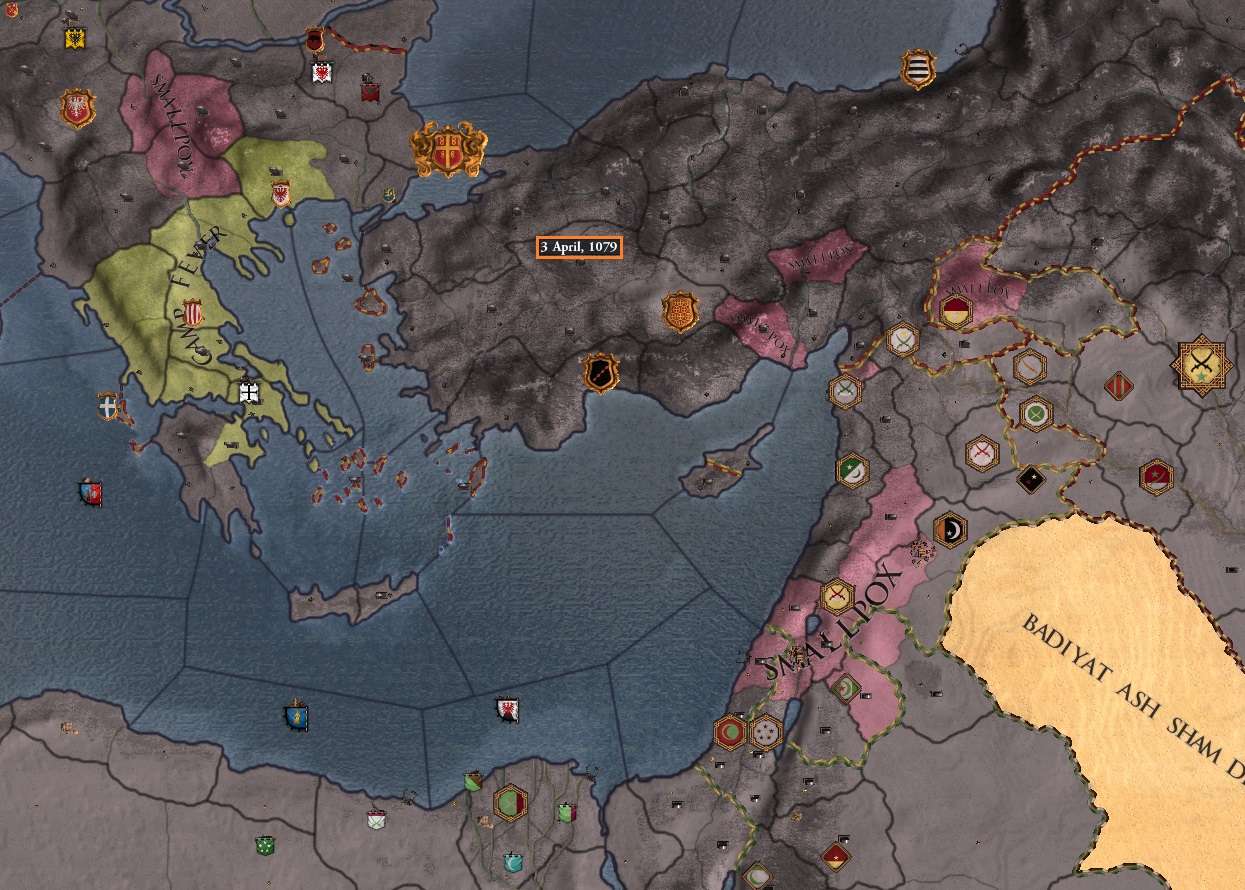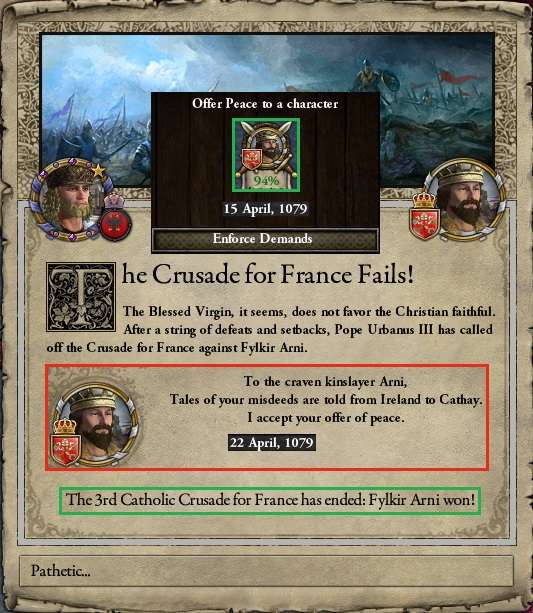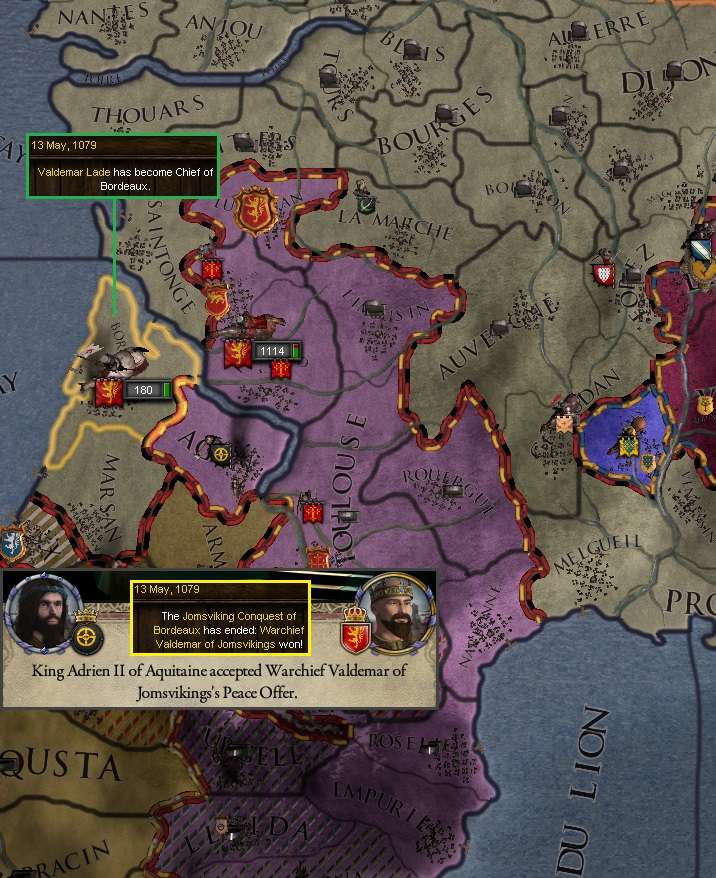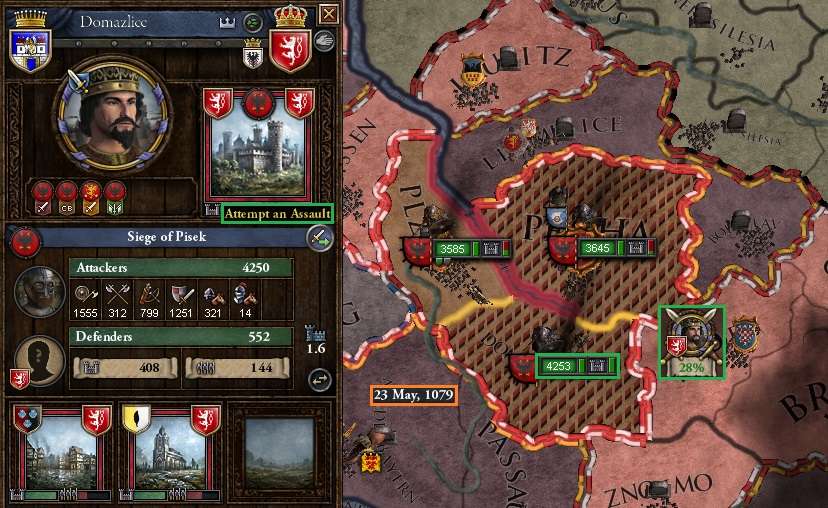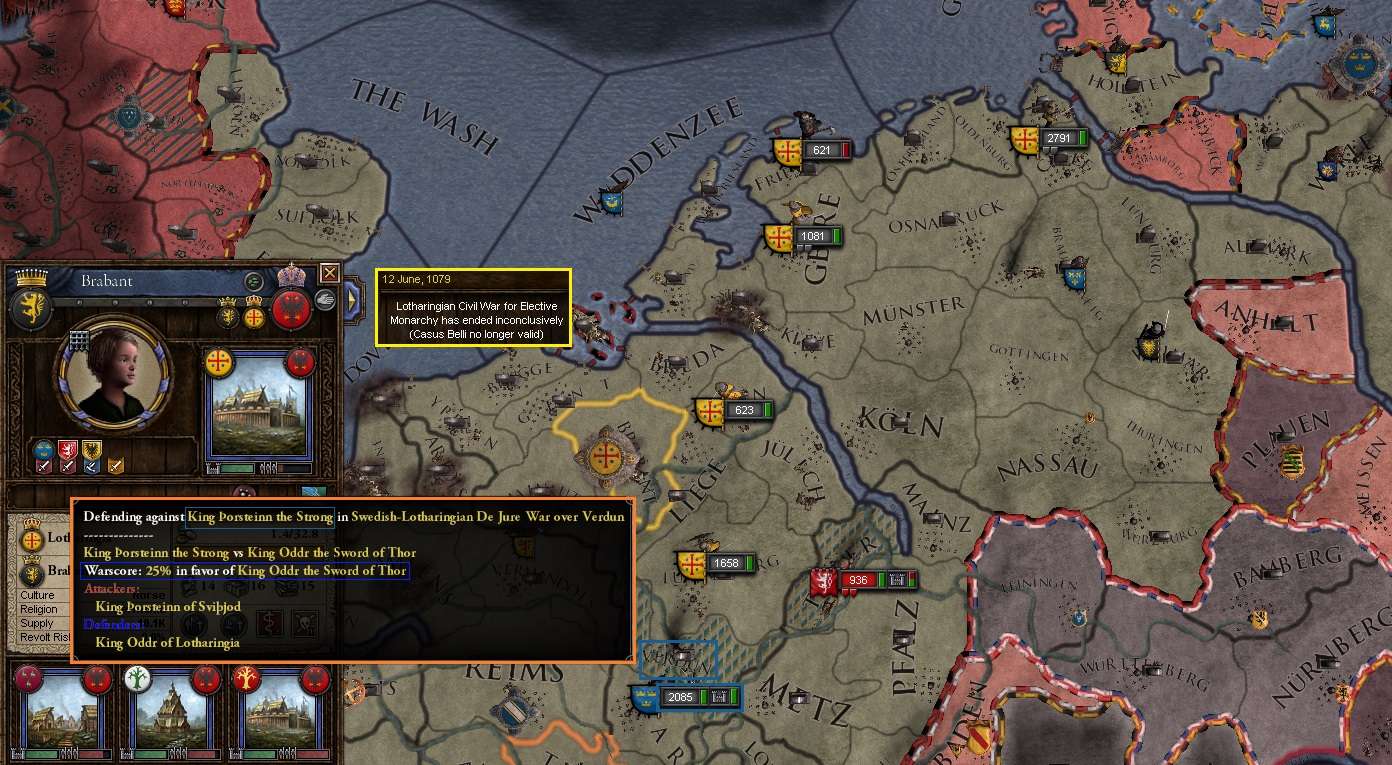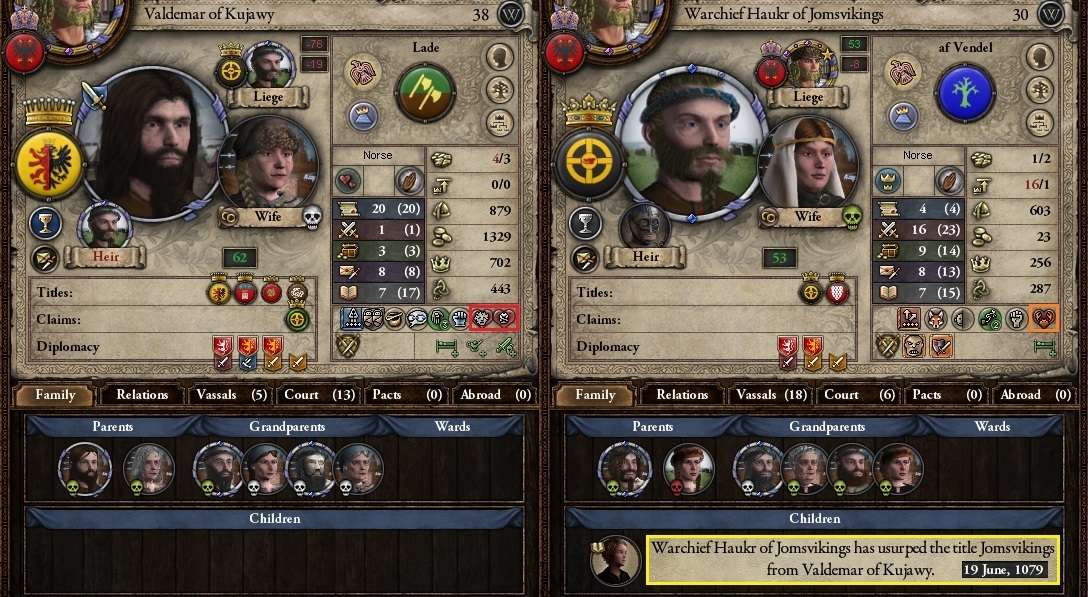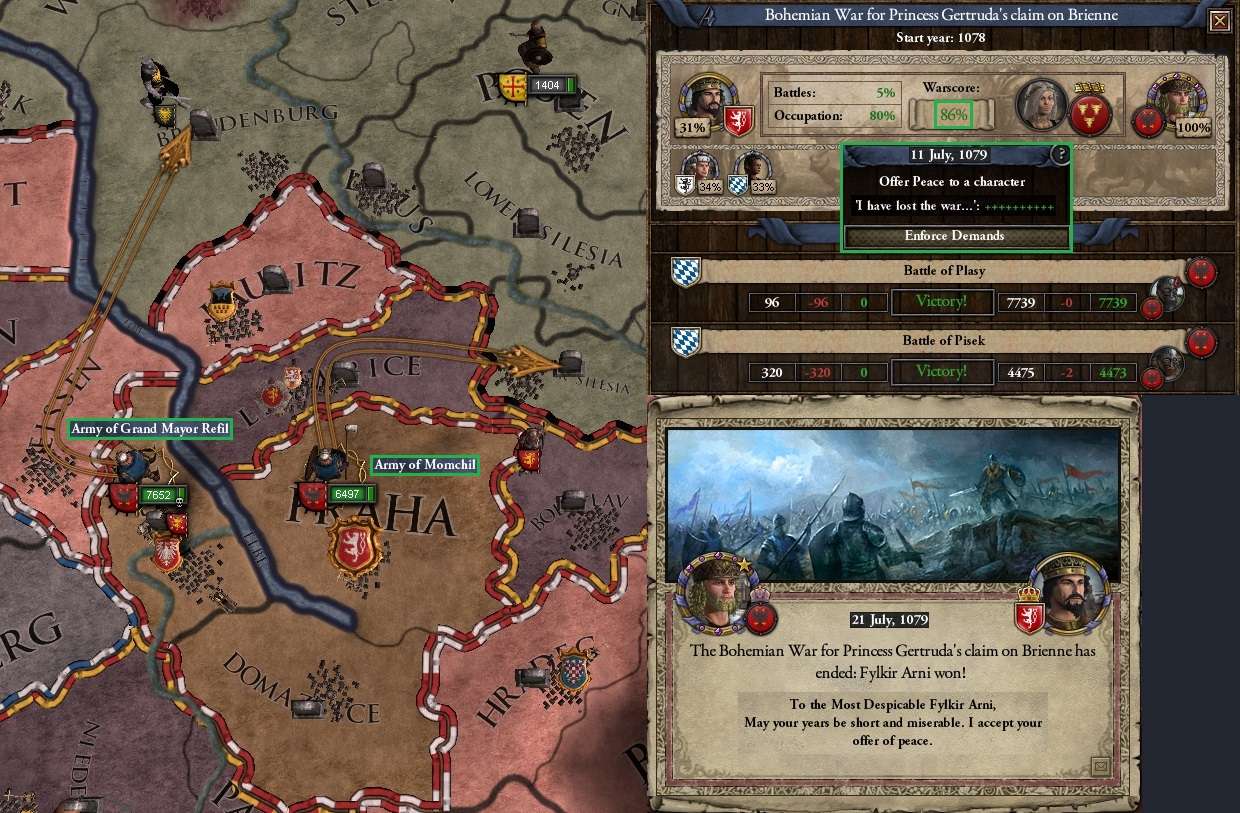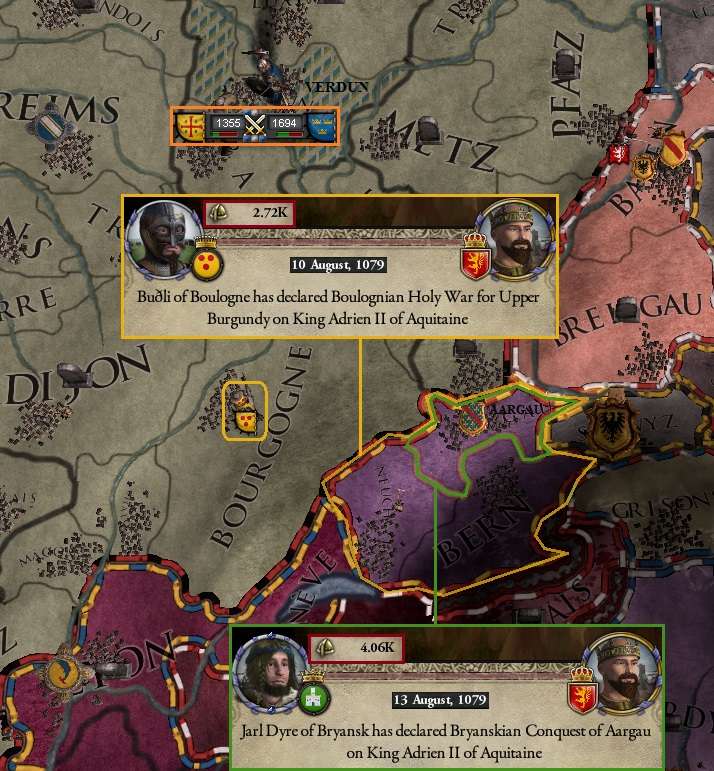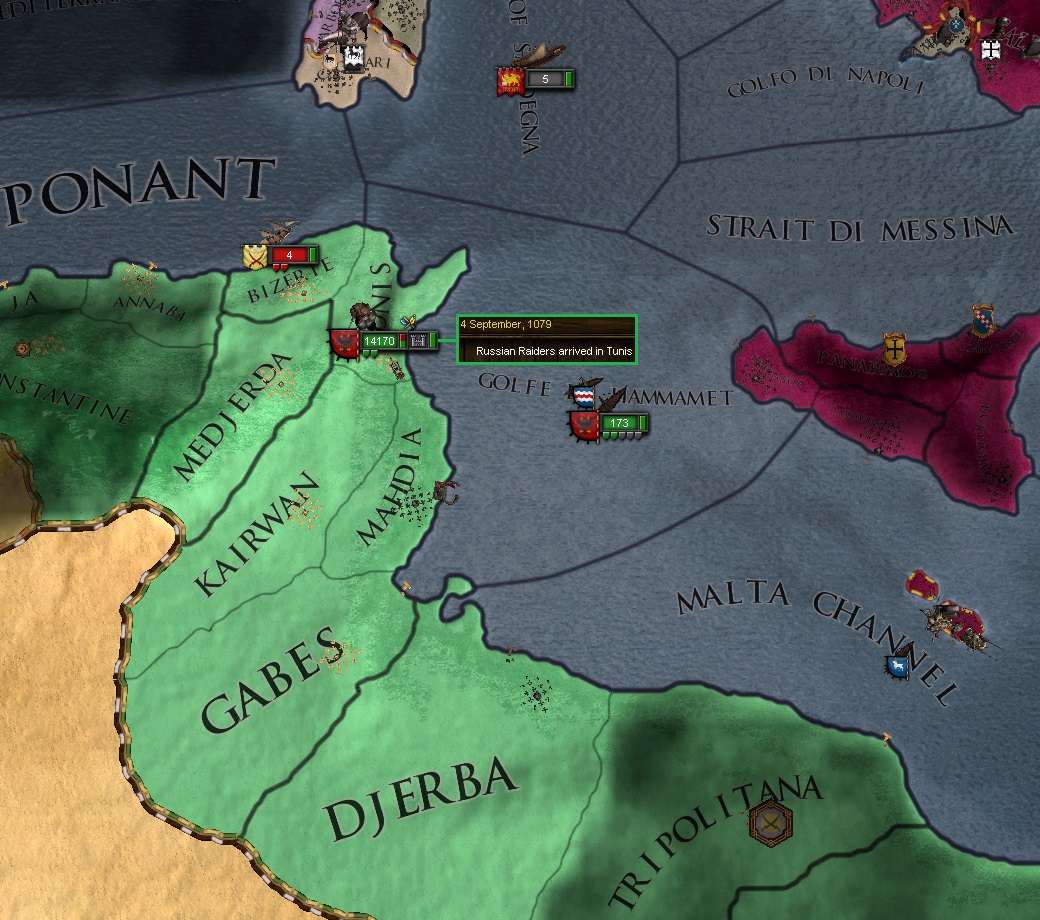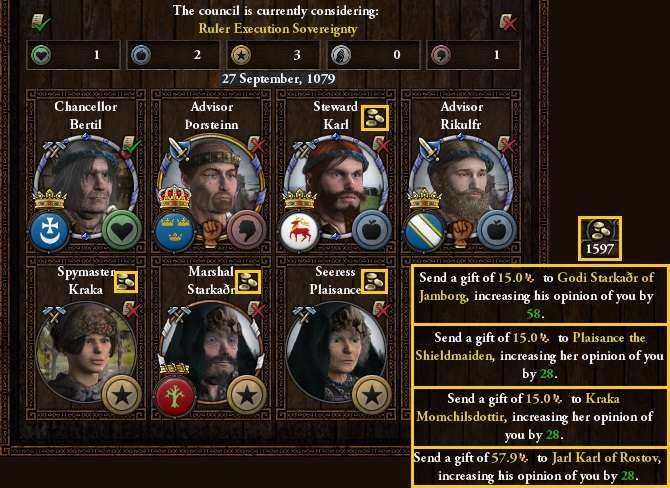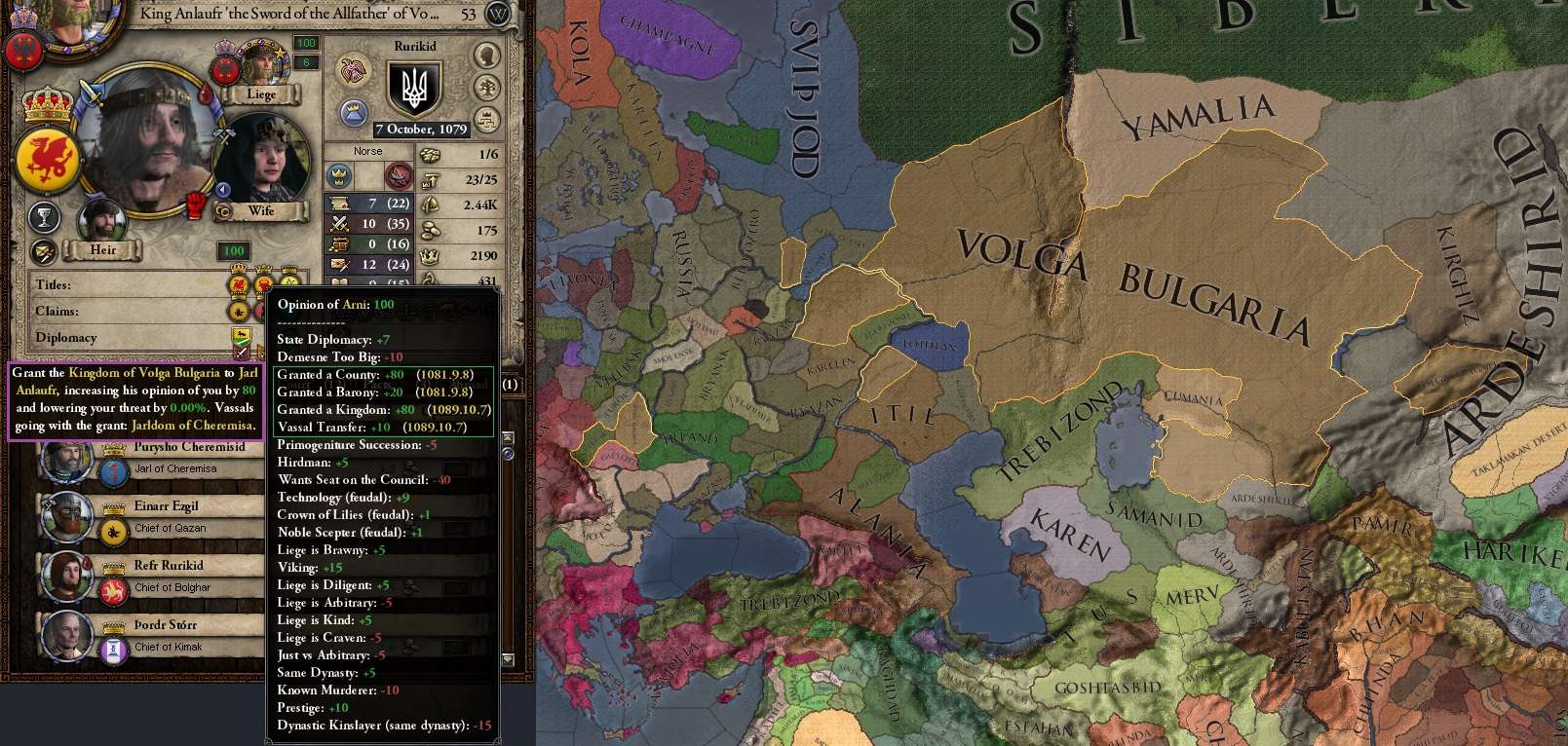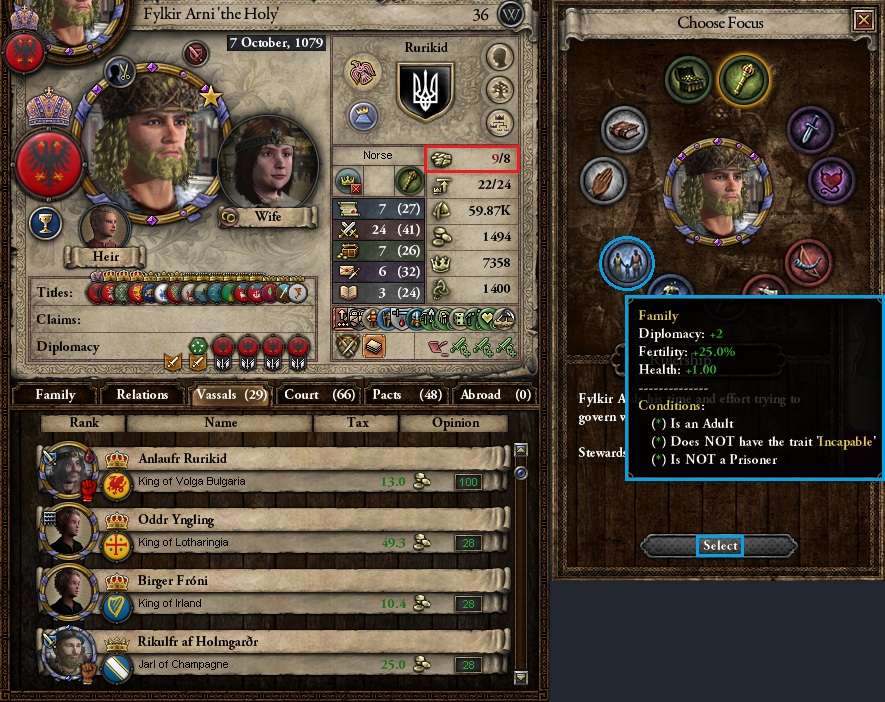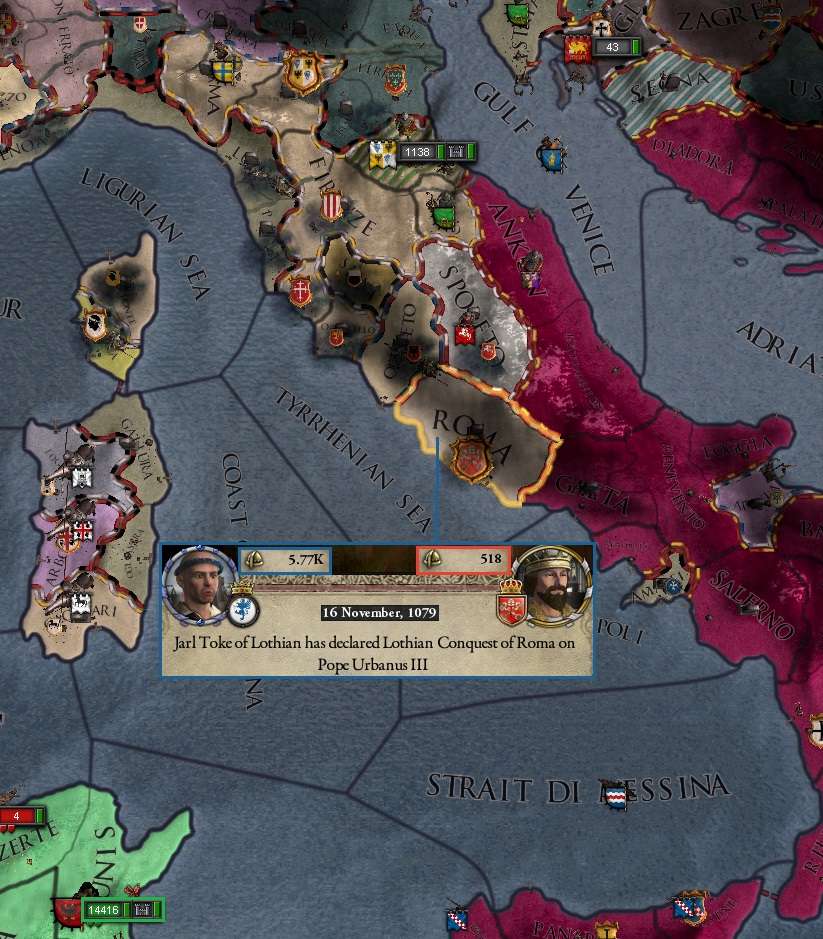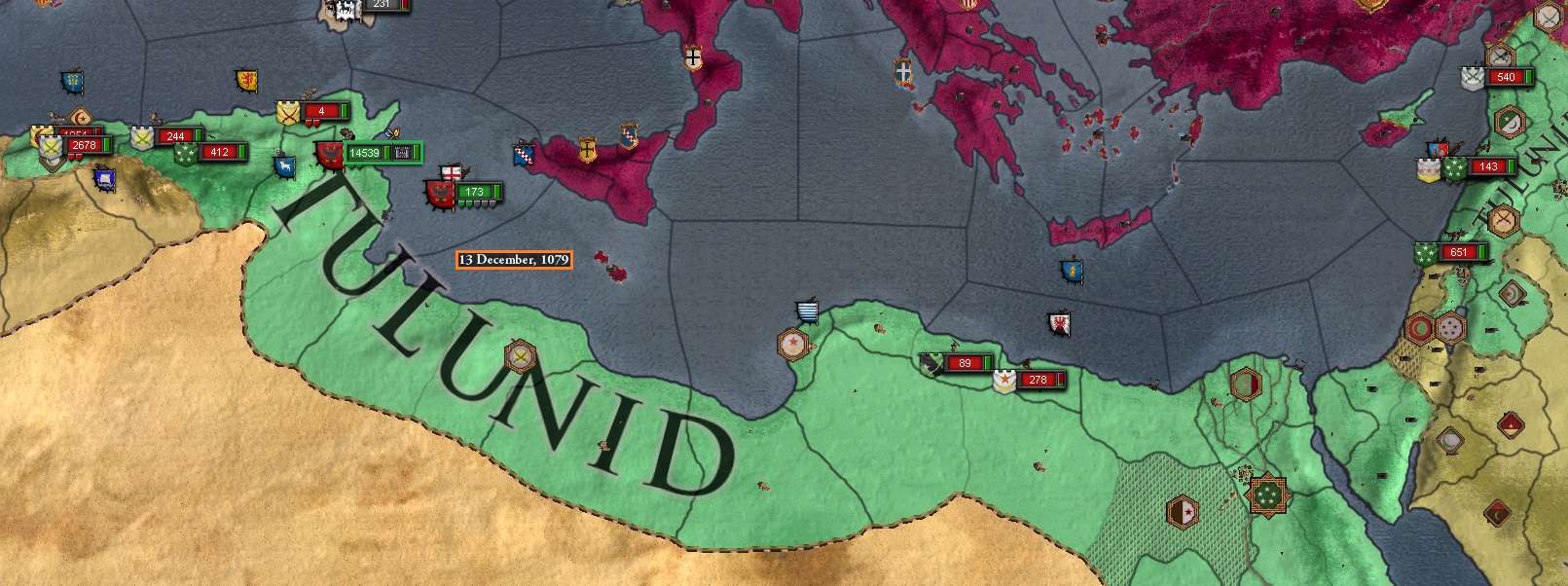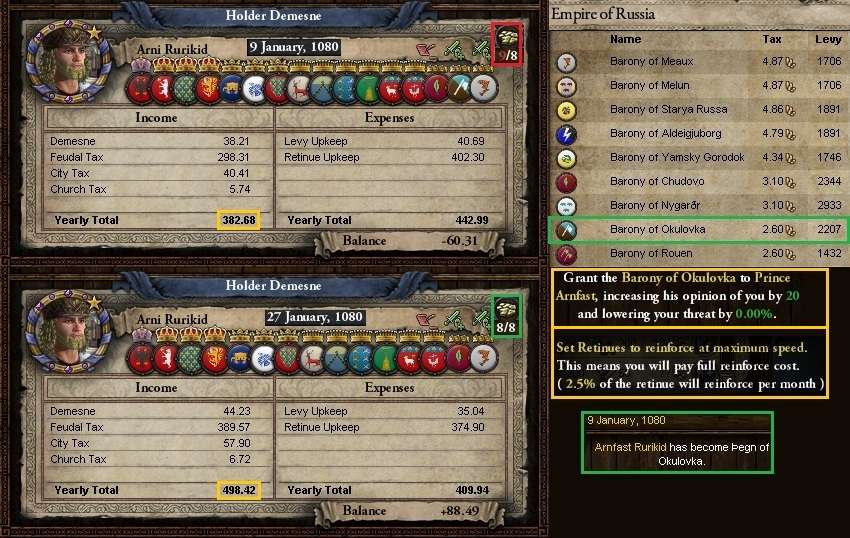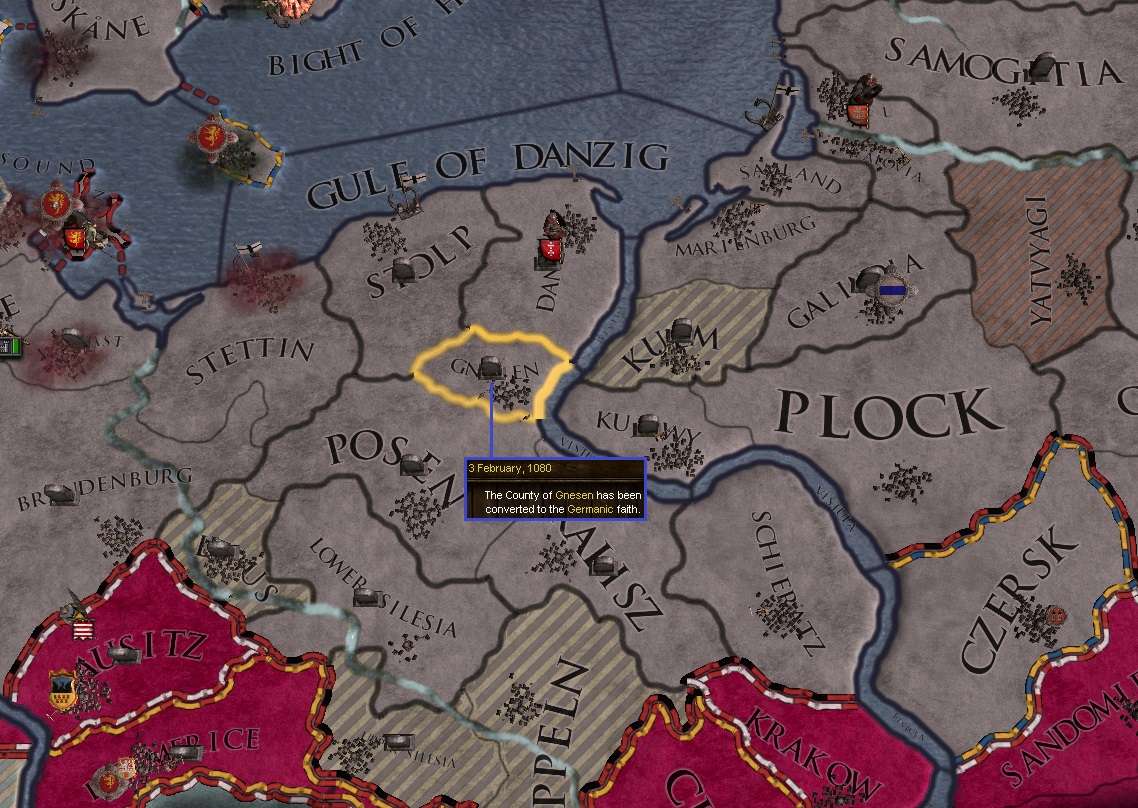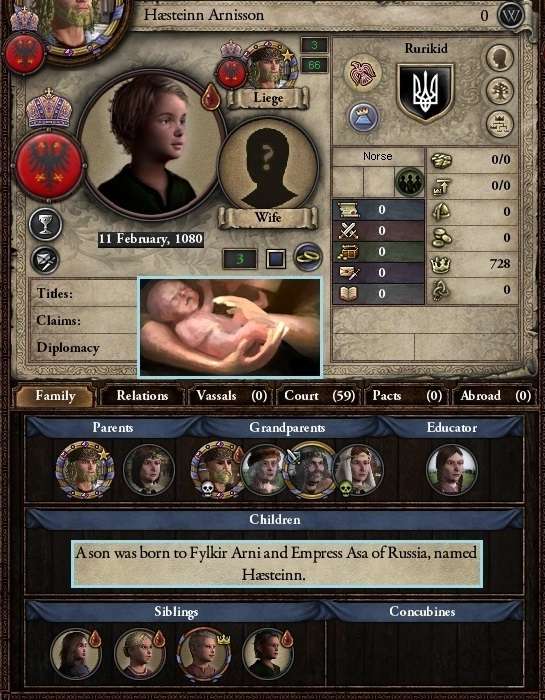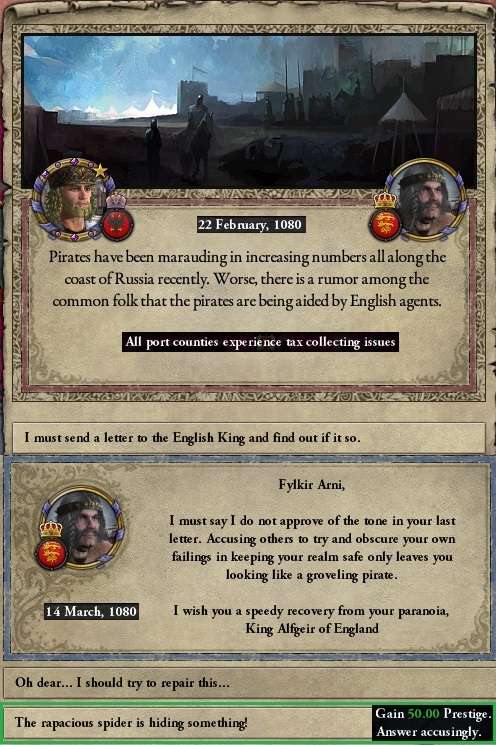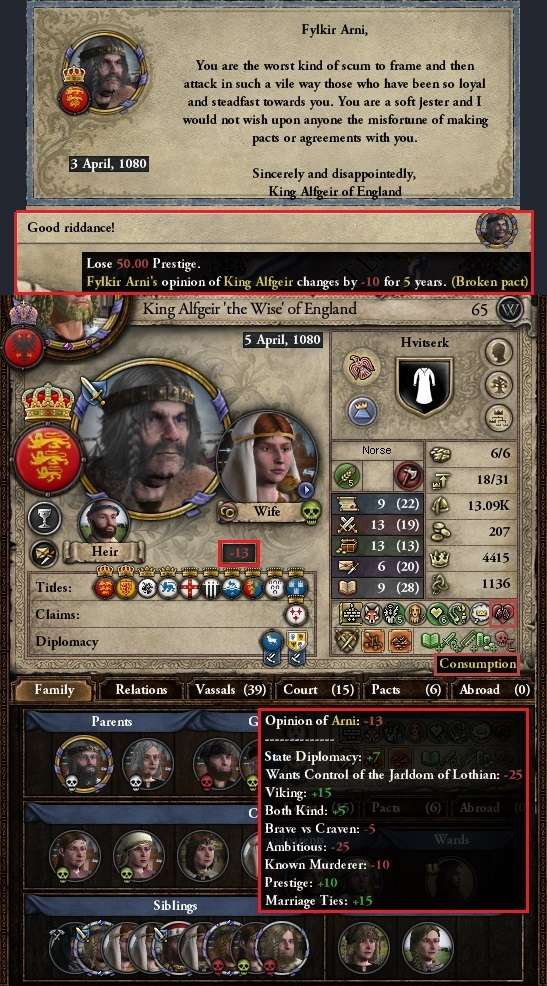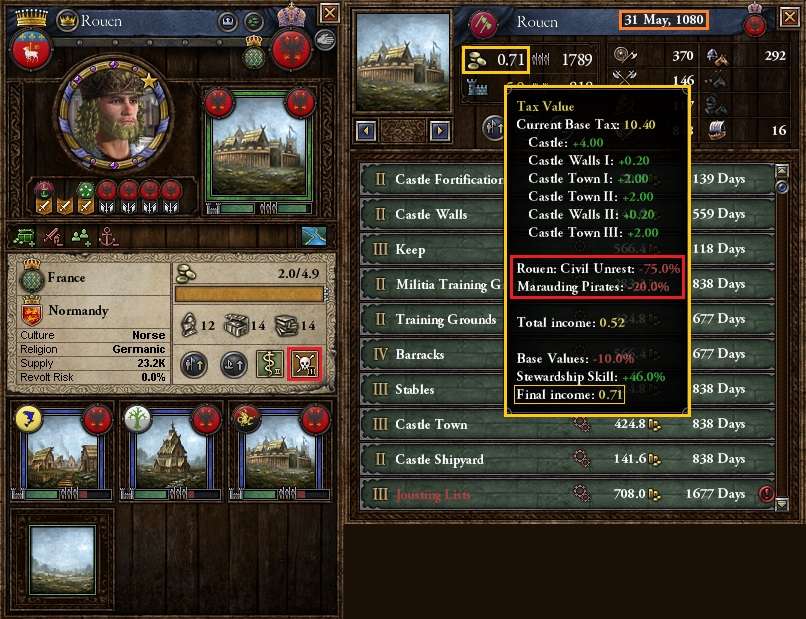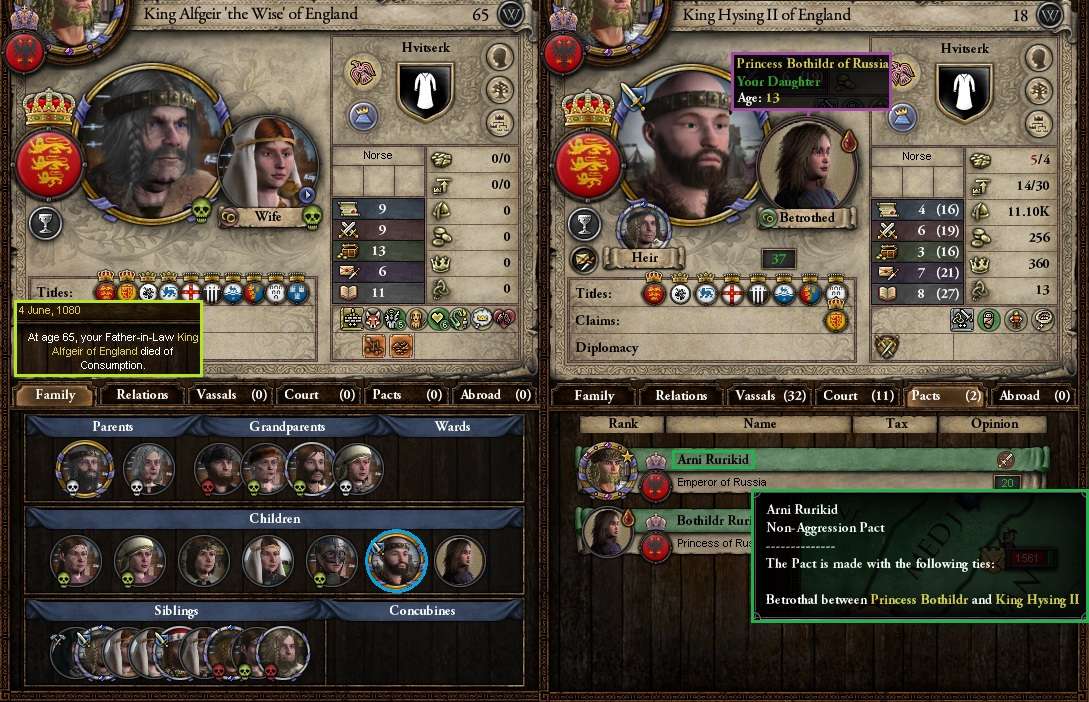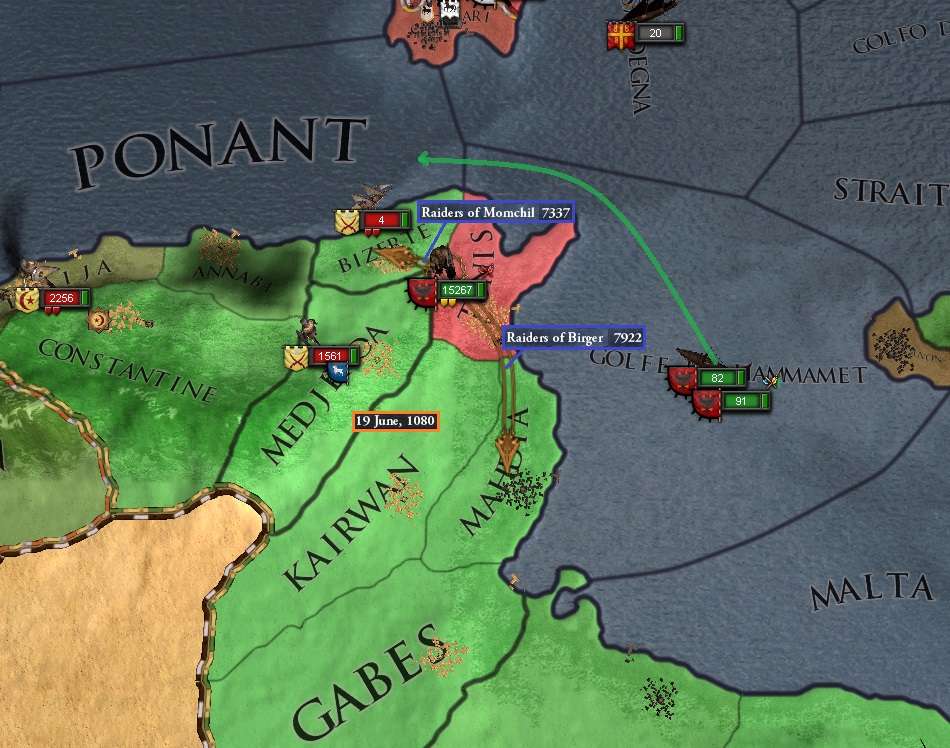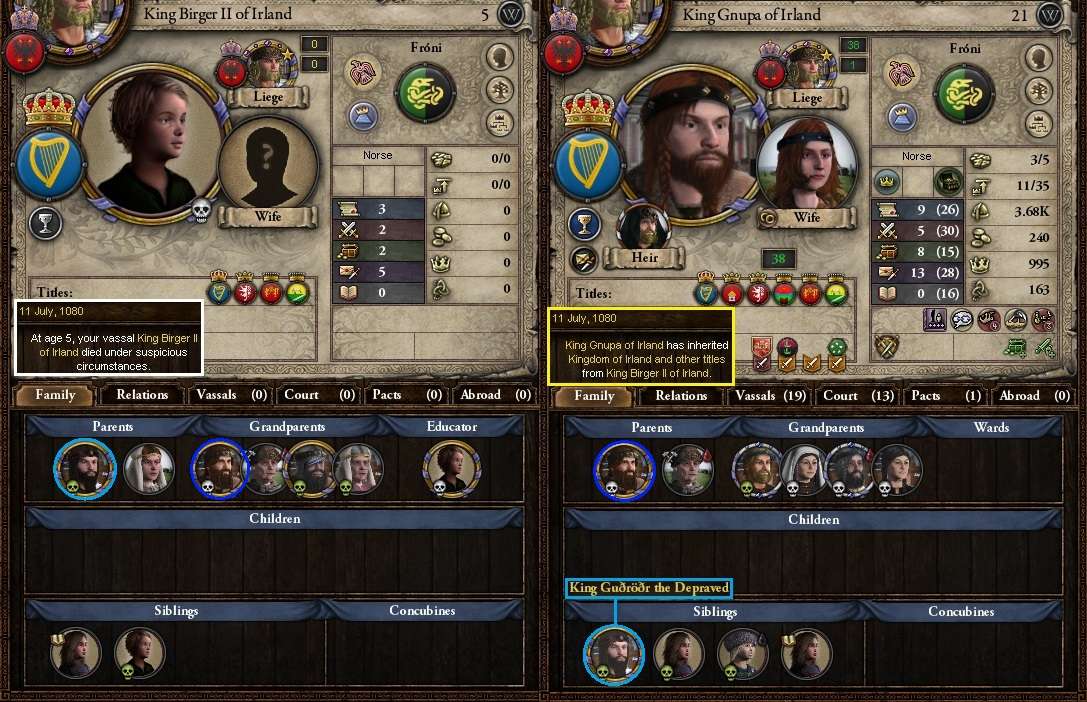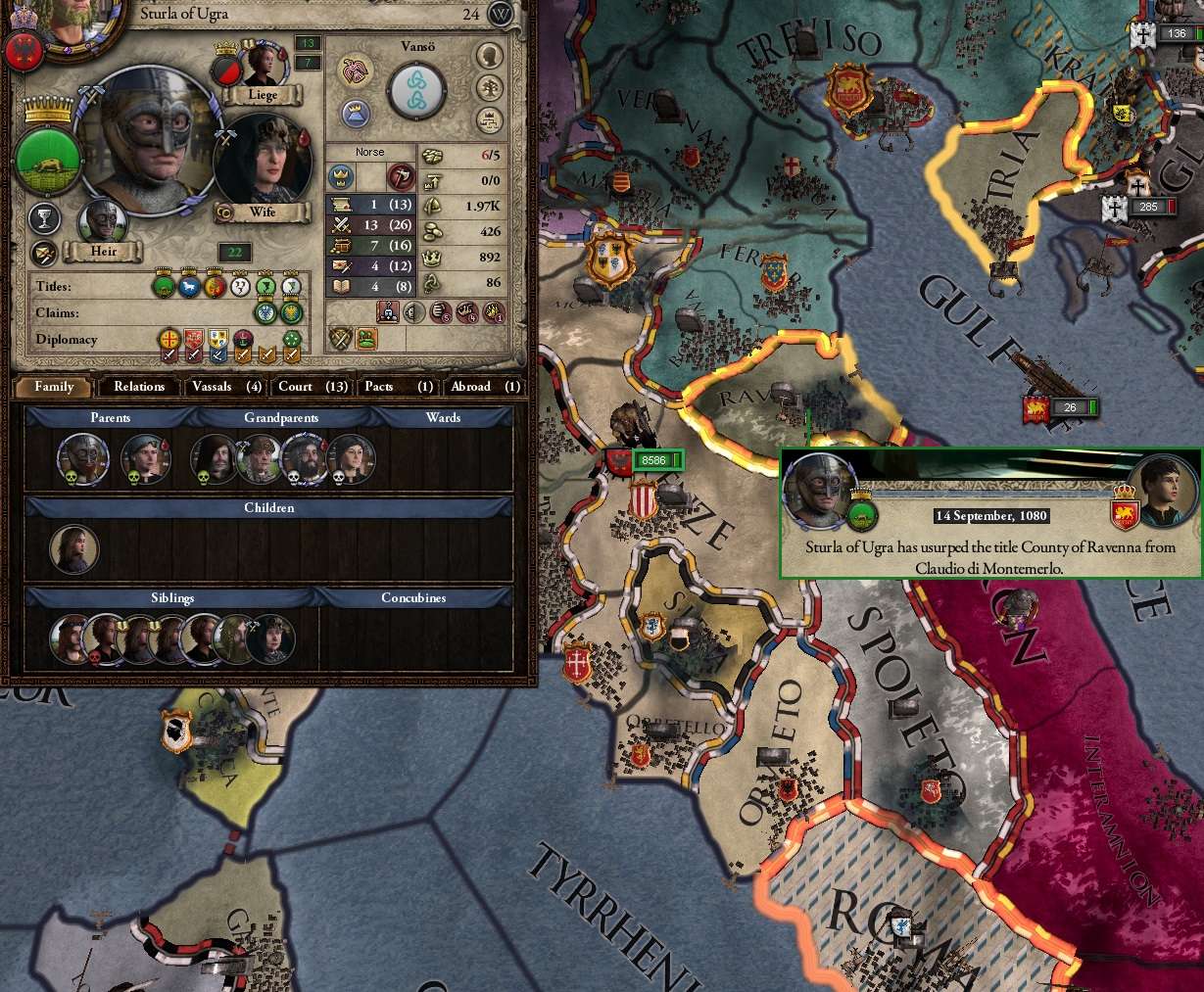Chapter 7: Suspicious Minds (April 1060 – March 1066)
ᚔ ᚱᚢᚱᛁᚲᛁᛞ ᚔ
1. War in the West: 1060-62
In early May 1060, Fylkir Hroðulfr was harbouring covetous thoughts about the powerful Orthodox kingdom of Hungary. He would like to smash them with a Great Holy War, as had been done with France way back in 992.
But the degree of Russian threat and comprehensive defensive networks (including Orthodox Byzantine support) limited the realistic prospects for that any time soon. Smaller fish would have to be fried for the time being.
ᚔ ᚱᚢᚱᛁᚲᛁᛞ ᚔ
Italy
In Italy, the Rostovan invasion of Italy limped on, but to little effect. But the Lothian War for Genoa that had begun in February 1059 was more likely to succeed, so Eormenric’s raiding army (around 7,000 men at that time) moved to assist in early April 1060. He looted five holdings from April to September for around 300 gold, while the Lothians (2,000 men) intercepted and defeated a Salluzzian army (1,500 men) to the north in Dauphine during May.
The Lothians then joined Eormenric in Genoa in late July to help and all five holdings were occupied by successive easy assaults from 26 September to 6 October. Duchess Anna quickly sued for peace with the still-imprisoned (by Count Simone of Lombardy) Jarl Frirek II.
‘Commercial’ Raiding: 1060-62
While Eormenric support Frirek in Italy, the other army under Sumarliði had kept its raiding up in Neuchatel, sacking four holdings between January and August 1060, losing 447 men for 238 gold. During that time, Doge Giorgio of Venice finally saved the 145 gold for his ransom, one of the largest ever taken by the Rurikids. Sumarliði moved to Baden next, sacking five holdings for no loss and 325 gold from October 1060 to August 1061. He then headed off to support the Jarl of Brabant in a short war during 1061-2.
With Genoa taken, Eormenric headed across for another
chevauchée in eastern Aquitaine, which had recovered enough from the last raid to be worth looting again. By late December 1060 they were in Rouergue, where they would raid until September the next near (212 gold), moving next to Narbonne (239 gold) from October 1061 to May 1062; then Gévaudan (272 gold) from Jun 1062 to April 1063. After his short campaign in support of Brabant, Sumarliði moved onto Nassau, taking 291 gold from May 1062 to January 1063. All bonuses for the already overflowing treasury.
ᚔ ᚱᚢᚱᛁᚲᛁᛞ ᚔ
Brabantian Conquest of Thüringen
Young Jarl Sigurðr of Brabant was an enthusiastic but barely competent soldier. It did not stop him from launching many wars and often commanding a flank in battle. His latest war for Thüringen against its independent Count Hartwig was launched in August 1061. Sumarliði soon interrupted his ‘commercial’ raiding mission to offer support, raiding two holdings in Thüringen for 146 gold in late 1061 to early 1062.
He then slipped across to engage a Thüringian army of 1,600 men investing Brabant itself, destroying over half their army by 12 March 1062 at the Battle of Leuven for the loss of only 31 Russian raiders. He then headed east, winning another skirmish in Kleve on 5 April. But the same day, Sigurðr claimed his victory, allowing the Russian raiders to head back to resume business in Nassau.
ᚔ ᚱᚢᚱᛁᚲᛁᛞ ᚔ
2. Domestic and Foreign Affairs, 1060-62
1060-61 – Drinking Time
This was a busy period back at the Imperial court in Nygarðr. In April 1060 King Leopold of Denmark, though with a great opinion of the Fylkir, still refused a non-aggression pact due to ‘political concerns’ and no dynastic marriage was available to clinch one that way.
The old Chancellor, Mayor Styrbjörn of Paris, died of stress in April 1060 and was replaced by the highly competent and well-disposed Jarl Bertil ‘the Wise’ Rurikid of Belo Ozero. Mid-year, word came back that the Roman Basileus Eustratios II had come of age, known as a flamboyant schemer who wanted to groom an heir but did not yet have a wife. He retained a decent opinion of Hroðulfr due to past diplomatic influence.
The Rurikid ‘cancer cluster’ continued in September with the death of the Fylkir’s brother Hakon Helgisson at the age of 49 in September that year. There were worries it had begun to ‘run in the family’. Then more bad news came with the discovery of Hroðulfr’s lover Linda by his angry wife Empress Ylva in November. The Fylkir countered by taking an official concubine instead, without missing a beat!
Early the next year, Hroðulfr decided to do some carousing, inviting old Jarl Refr of Yaroslavl for some feasting to see if he could improve relations. Even though King Botulfr tried to ‘harsh the vibe’ with a baseless accusation, the Fylkir ignored the slander; he and Refr became great friends. The weeks of feasting also boosted his diplomatic credentials, though couldn’t lift the depression he had suffered for years now.
In good diplomatic news, Denmark was ready to accede to a non-aggression pact in February 1061 after a change of heart by Leopold. And young Prince Borkvard came of age the next month, marrying his betrothed Norwegian princess in a good dynastic match.
By May, Basileus Eustratios Makedon became known as ‘the Mutilator’ – which Hroðulfr rather approved of – but
still had no wife. The rest of 1061 was quieter at court, the main excitement being an unsuccessful attempt at some hawking leading instead to a late blooming of Hroðulfr’s poetic streak – from the mews to the muse!
1062 – Legal Eagle
By February 1062, Hroðulfr would become recognised as a genuine court poet in his own right. At which time, a door closed with the murder of King Leopold of Denmark (like Hroðulfr, himself a notorious kinslayer). Only for another to open: the new King Ivar was unmarried at 26 and it so happened that one of the Fylkir’s daughters was available to be his wife, cementing Danish-Russian relations even more closely.
With a huge treasury surplus, in April Hroðulfr decided to issue ‘bonuses’ to four of the members of the Imperial Council in 1062. By May, three of the four so rewarded counted themselves as Loyalists: important to enable some more council law reform to be pushed through.
In late June 1062, King Botulfr had about 1,800 troops of his own in place in Vestmannaland when a peasant revolt with 2,600 rebels broke out. Despite being heavily outnumbered, the King of Sviþjod had crushed the rebellion on Hroðulfr’s behalf by 1 August after a hard fight. Later that month, the Rostovan prepared invasion of Italy was formally lost by Jarl Hroðulfr. Despite considerable early help from the Empire, it had never looked like succeeding.
The Fylkir used his numbers in the Council to pass a law change to restore full Imperial control over the revocation of titles on 6 October. He would need to wait another five years before moving onto the next one after this first clawing back of powers to the Crown. At that time, Jarl Frirek was still in prison to the now Duke Simone, so Hroðulfr sent a gift of 92 gold which he hoped might allow the jarl to ransom himself when added to the 75 gold he already held.
By November 1062, all the top 16 Russian vassals had a positive view of their Emperor except for the powerful Jarl Öysteinn of Champagne – who it was noticed still carried a mystifying grudge about raised levies. It was finally tracked down on 1 December to a small flotilla of ships that were never physically located but remained ‘on the books’ from past raiding years before
[malus of -54 by then]. With them dismissed, his anger would slowly dissipate.
ᚔ ᚱᚢᚱᛁᚲᛁᛞ ᚔ
3. France and Germany, War and Raid: 1063-64
3rd Brabantian Holy War for Brunswick
Jarl Sigurðr was at it again in December 1062, declaring war against the Teutonic Knights again, this time effectively for Lüneburg. Thrashing the Teutons was always good sport, so Sumarliði was soon marching up from his raid in Nassau to lend a hand. After winning a short skirmish against some Teutonic Knights on 25 February, they settled in for some siege work. A week or so later, one of Sigurðr’s armies was giving an outnumbered Teuton force led by Hochmeister Baldewin himself a beating in Münster.
But by early May an allied enemy army of over 5,000 was thrashing a smaller Brabantian force to the west, so Prince Arni (see later on how he ended up swapping positions with Sumarliði) broke his siege of Lüneburg to take them on. The enemy (mainly Bohemians) were engaged in the Battle of Osnabrück on 27 May. Over the next four days, Brabantian contingents reinforced the line successively to see the enemy outnumbered by two-to-one and beaten in the decisive engagement of the war.
By the time Arni got back to Lüneburg, the Brabantians were in place, so his troops were able to assist the sieges and assaults that saw the four holdings occupied from 9 July to 25 September. Sigurðr – now known as ‘the Dragon’ in honour of his latest victory, had further expanded his demesne and the realm’s borders. The Russian threat level was slowly decaying, despite these periodic vassal conquests.
His work done in Lüneburg, Prince Arni was sent all the way around to Bulgaria for his next raiding mission.
ᚔ ᚱᚢᚱᛁᚲᛁᛞ ᚔ
‘Commercial’ Raiding: 1063-64
In mid-April 1063 Eormenric finished his raid of Aquitaine to engage a sizeable host that was ravaging Provence. And as mentioned above, Prince Arni took over Sumarlidi’s raiding command in the north on 22 April 1063, before leaving Nassau to help Brabant in Lüneburg.
Eormenric (8,800 men) eventually ran the raiding host (3,000) down in Venaissin, heavily defeating them at the Battle of Carpentras on 11 June. He then marched around to Limousin to continue the interrupted raid of Aquitaine. He had sacked one holding there (87 gold) by 2 December 1063. Prince Arni would arrive in Bulgaria in mid-April 1064 to begin a raiding campaign in southern Hungary, to both gain some revenge for his uncle Helgi’s death their some years before and to start “softening them up” for the future.
ᚔ ᚱᚢᚱᛁᚲᛁᛞ ᚔ
Jomsviking Conquest of Thouars
The Aquitanian exclave of Thouars was held by the rebel Lollard Count Payen ‘the Bold’, when Warchief Surt declared war on him in September 1063. Botulfr had taken over the southern raiding army by December when he moved over from Limousin to assist Surt in his reduction of Thouars. Four holdings were taken down between then and 24 February 1064, though 1,200 attacking troops were lost in the assaults. The lightning war was won very quickly.
Brabantian Holy War Thüringen
On 26 November 1063 Jarl Sigurðr launched a new war for a part of the Duchy of Thüringen he didn’t already control: Göttingen, owned by the independent Count Gottfried. It seemed Brabant would not need much assistance with this conquest, but during a routine engagement (won by Brabant) in Göttingen, the Jarl fell gallantly in battle.
His young son Sumarliði inherited both the largest Russian sub-realm after the Emperor himself and the holy war now being fought in his name. This also provided an excellent opportunity for Hroðulfr to bind the Brabantian branch of the Ynglings to the Imperial family and to see his bastard granddaughter Hafrid to an excellent match to which the young Jarl’s regent quickly agreed.
Five months later the war was all over and at the age of just 3, the toddler jarl already had a nickname for life and the Rurikid empire had expanded further yet into western Germany.
Southern France – War and Raid
As those events played out, one of Jarl Frirek’s vassals managed to usurp the county of Forcalquier from a very careless Dauphine lord, who seemed to have just left it lying around to pick up! Even so, Russian threat levels continued to trend down overall.
In mid-May 1064, Chief Ivar ‘the Sword of Odin’ (imposing nicknames being a must-have for your aspiring 11th century Viking Rurikid magnate) of Macon launched a holy war for Dauphine. Some assistance looked advisable, so Botulfr broke a raid he was conducting in Lusignan in early June to head across.
He had helped Ivar take one of the holdings in Lyon when – for reasons now lost to the historical record – the war lapsed due to the
casus belli becoming ‘invalid’. Finding rich pickings in Lyon, Botulfr stayed on to raid, sacking five holdings by mid-June 1065 for 340 gold and the loss of 873 raiders.
ᚔ ᚱᚢᚱᛁᚲᛁᛞ ᚔ
4. Domestic and Foreign Affairs, 1063-64
1063: Love, Hate and Marriage
Suspicion, infidelity, Lollard rebellion, tragic accident and the sinister scourge of cancer were recurrent themes for these two years. But this was contrasted with increasing prosperity, fulfilled ambitions, celebrations and the return of a prodigal grandson to the Imperial family’s heart.
First, Prince Arni, second in line to the Imperial throne, saw the same lure as his uncle Helgi and took up the adventurer’s mantle in April 1064. It seemed an appointment as Imperial marshal was not enough to keep an ambitious but unlanded Rurikid scion at home! Even though he wasn’t actively raiding Russian land, while he remained in the realm Hroðulfr could negotiate with him.
The price of bringing Arni home would be gifting him the trading hub of Tana. At first this appeared a high price, but the treasury by this stage was massively over-filled (over 5,000 gold and growing with not enough to spend it on) and the county would return to Imperial hands anyway if Arni inherited one day.
The offer was made and accepted after just a week of Arni’s expedition. But it seemed Arni could not be reappointed Marshal yet after having just relinquished the post, so the experienced general Sumarliði took on that role, while Arni took the role of Imperial commander and leadership of the raiding army in Germany, to gain some direct battlefield experience.
But the Norns are notoriously fickle and early next month the brilliant Empress (and Seer) Ylva was diagnosed with cancer. Ofeig once more gave excellent treatment but could not offer a cure. He also reported to Hroðulfr the alarming news that she had the lovers’ pox! While the Fylkir pondered how she had contracted that, he paid Ofeig both for his good work and silence.
In August, Hroðulfr’s promiscuous daughter Freyja, who had already given birth to the bastard daughter now betrothed to the infant Jarl of Brabant, this time bore a son to that infamous cocksman Buðli the Lecher. Freyja, 29, was quickly married off to an obscure courtier named Grimr, who was happy to take her despite the matrilineal terms, her racy history – and
her case of lovers’ pox! The blow to Imperial prestige
[-400] hardly mattered to the imposing Fylkir and Emperor
[then at around 25.5k prestige].
In October 1063, Sigurðr (not yet having met his fate with the Valkyries) created the additional title of the Jarldom of Flanders for himself. Hroðulfr had no objection to this: it seemed fair recognition for a successful marcher lord. Shortly afterwards, Sigurðr’s short term as Marshal came to an end. His place was taken by one of Hroðulfr’s militarily inclined half-brothers, the deal sweetened with a small bag of gold.
But the Empress, mother of seven of the Fylkir’s children, lost her fight with cancer in the same month. Hroðulfr quickly needed a competent spouse to help him manage his sprawling realm and his ‘talent scouts’ discovered a young provincial noblewoman named Ingrid Hjalmarsdottir Styr as the most suitable available. She did seem to have many good virtues.
The marriage was held a week after Ylva’s funeral. Incidentally, this changeover reduced the Emperor’s demesne management limit by one, further mitigating the earlier granting of Tana to Arni.
A new Seer was also needed and none other than the very loyal and talented Court Physician Ofeig was further rewarded for his sterling service with promotion to Council in November 1063. He would later prove his value in this role, too.
The loss of Ylva’s management skills had also forced Hroðulfr to reduce his vassal numbers. He aimed to do this by creating the Jarldom of Burgundy and awarding it to Chief Ottarr of Bourges. But even though the ‘levy malus’ for Jarl Öysteinn was slowly decreasing
[only down to -48 by then] he was now a malcontent presence as Advisor, while the rest of the Council (despite being dominated by Loyalists) were
all beholden to him through favours.
So Öysteinn used his influence to turn the rest of the Council against the proposed grant. Nor would he consent to see it given to King Botulfr of Sviþjod – who was forced to vote against his own interests! Seeing where this was going and not wanting to be branded a tyrant, the Fylkir offered the title to Öysteinn himself. And filed away this as the next area for legal reform!
Of course, this time the vote to approve was unanimous. It did have the benefit of making the great magnate a far happier camper to counteract his residual ‘levy-angst’. And it gave him a kingdom-sized demesne within central France, in between Brabant to the north and the Jomsvikings to the south.
ᚔ ᚱᚢᚱᛁᚲᛁᛞ ᚔ
1064: An Eventful Year
Jarl Hroðulfr ‘the Chaste’ of Rostov was the next victim of the Russian cancer cluster, succumbing in February 1064 at the age of 58. Was it too much red meat? The mead? If so, then the Great Blot held from February-April 1064 wouldn’t have done the assembled vassals any good! Though the hangman proved a more immediate threat to life for the four long-term prisoners sacrificed as part of the ceremony.
Old Refr got another of a series of favours as he arrived at the Blot: 200 gold to help fund some fight he was engaged in. The old Jarl was overflowing with gratitude as the friendship stayed as strong as ever. Which could not be said of the Fylkir’s relationship with his new wife, who had both the lovers’ pox and a child on the way – which she
claimed was Hroðulfr’s. He was doubtful and acted on those suspicions, even though the first investigation turned up nothing incriminating. He dug deeper.
Soon after the Blot ended, the Emperor’s ambition to see the realm prosper came to pass after five years of technical peace (aggressive raiding aside).
But that was soon overshadowed by the spies’ latest report on Empress Ingrid: a sordid affair with Chief Asbjörn of Chernigov had been uncovered. This treason would not be swept under the carpet, with the “unfaithful harlot’s” transgression made public and used as grounds for divorce. As for Asbjörn, he would ‘keep’ but was now surely a marked man.
This time, Hroðulfr took the “safe” path by taking an older previously unmarried provincial Seeress as his fourth wife. Alvör was generally competent, had no known scandals to her name and would help manage the realm as the Fylkir got his more physical needs catered for by his concubine Ingrid (
not the ex-Empress).
Seer Ofeig did more good work when he apprehended none other than Buðli the Lecher, ravisher of Hroðulfr’s daughter Freyja, in July 1064 as an open devotee of the Fellowship of Hel. The Fylkir watched on with joyful satisfaction as the man’s sins were repaid with cleansing flame! One down down, one to go.
A Lollard-led Polish liberation revolt broke out on 1 September with over 4,000 rabble infesting Gnesen on the Vistula. Sufficient Imperial levies were mustered from the core counties of Russia and sent on their way, but the reckoning would not occur until the new year.
In excellent news, the Gods provided their own punishment to Asbjörn ‘the Lecher’ of Chernigov, self-proclaimed master seducer (including of the former Empress Ingrid). He died of ‘severe stress’ on 7 October 1064 aged just 30. Thinking on it over the next month, Hroðulfr resolved to simply let it go. The relief at last removed the feelings of depression that had haunted the Fylkir for so many years.
By November, Rouen had fully recovered from its earlier consumption epidemic and was prospering once more. And Birger of Pereyslavl fulfilled a great ambition by creating a sixth kingdom and seventh crown (including the Fylkirate) of the Empire on 15 May 1064.
The Gods rewarded King Birger’s achievement in typical fashion, just 12 days later.
His two major holdings were split up between his two young sons.
As 1064 ended, the most powerful magnates in the realm were all on good to excellent terms with their Emperor, factional activity was minimal and Hroðulfr’s power still comfortably outmatched the six next most powerful lords combined. And he held an enormous treasury which could easily be used to hire mercenaries at need.
ᚔ ᚱᚢᚱᛁᚲᛁᛞ ᚔ
5. Sword and Sack: 1065-66
‘Commercial’ Raiding: 1065
Prince Arni raided in Hungary at Temes, losing 189 men and grabbing 206 gold up to February 1065. By late April he was in the Hungarian exclave of Terebovl in Galich, sacking one holding for just 52 gold before being called away for other duties in Poland. Of interest, Arni still retained his personal raiding host of almost 2,400 men and 110 ships from his brief time as an adventurer. As he finished the raid on Terebovl Castle on 22 June, he discovered another of those strange locked chests: it was sent straight to his father’s treasury for safe keeping, until a key could be found for it.
ᚔ ᚱᚢᚱᛁᚲᛁᛞ ᚔ
Champagnan Holy War for Auvergne
One of Russia’s most powerful marcher lords exercised his increased resource in February 1065 with a very ambitious play: holy war against the still-formidable Aquitaine, ruled by old Queen Tiburge. Both sides were able to muster over 10,000 men in total from demesne or allies. Öysteinn could call on at least 13,000, including over 4,000 mercenaries hired for the campaign and almost 3,700 from his vassals.
Queen Tiburge ‘the Just’ Karling would die aged 70 in early July, succeeded by her son King Adrien – of house de Vasconia. By late October, each side had large armies of similar sizes in the other’s lands.
Prince Arni was sent down from Poland to assist Champagne, as the war was predicted to be an extended one. By March 1066, Champagne had defeated the main Aquitanian host in a battle not recorded in the annals of the time, but that had left Champagne with around 8,800 men and Aquitaine with just under 6,700: it must have been a bloody affair. On 3 March, the far larger Champagnan main army was in the process of routing a Templar army in Auvergne, which Öysteinn had partly occupied, while Arni approached Bourgogne from the north.
ᚔ ᚱᚢᚱᛁᚲᛁᛞ ᚔ
Lothian Conquest of Lucca
In parallel to this, Jarl Frirek II – finally released from prison – sought to expand down the Italian coast to Lucca, declaring war on the 11-year-old Queen Laura of Italy in March 1065. Botulfr’s raiding army was sent from their completed raid in Lyon to assist in mid-June. He would arrive on 1 September, assisting the Lothians to occupy all three holdings by 24 December, mainly by assault.
Botulfr followed the Lothian army to Modena, but the county became badly overcrowded, making them flee back to Lucca by mid-January 1066 due to the severe winter attrition. Botulfr went next to Parma and by 17 February 1066 had set up his siege works for some ‘commercial raiding’, as well as indirectly assisting Frirek.
ᚔ ᚱᚢᚱᛁᚲᛁᛞ ᚔ
6. General Events and Summaries, 1065-66
Domestic Events
Gnesen’s main holding fell to the Polish rebels on 31 December 1064, just as the relieving Russian levy army was approaching from the north, after crossing the Vistula into Danzig. The Battle of Lekno followed soon in the new year. The old campaigner Momcil led a host double the enemy’s size in a one-sided battle that ended the rebellion at a stroke. Its leader received Hroðulfr’s usual mercy for rebel leaders. That is, none.
On 11 January, the Empire’s coffers reached 6,000 gold for the first time as tax and raiding revenue outstripped what it could be spent on. Things soured on 9 February when the Fylkir discovered a letter from one Chief Kaarle – evidence of an attempt to seduce Hroðulfr’s concubine Ingrid.
Will these impudent cocksmen never cease their depredations!? he thought to himself. He hoped he could protect Ingrid from such bounders and cads.
But his suspicions were once again stirred when in June 1065 Ingrid gave him the happy news she was pregnant. The now jealous and wary Fylkir couldn’t quite believe it was all above board. He didn’t want to confront Ingrid directly and sent two sets of spies instead to get to the bottom of things.
Rather than relief when nothing untoward was discovered, the old Emperor was left with nagging suspicion instead. His mood was hardly improved when news of a second Lollard revolt in Gnesen was received in July, this time with a little other 4,000 rebel scum infesting the county. As mentioned previously, Prince Arni would respond from Terebovl, so the levies would not need to be called out, saving time and expense.
As in the first rebellion, Gnesen’s fort fell as the relief column approached. Arni struck from the south on 5 October and prevailed after a hard fight by 2 November. After his capture, the rebel leader proclaimed Hroðulfr to be an evil tyrant, among other things.
It was decided that a slow flaying to death would be the suitable response to such a futile insult. Arni was then off to help Öysteinn in France after this enjoyable entertainment.
The Emperor was saddened to hear of the death of Jarl Refr on 27 October, though he had passed away peacefully after a long life of 73 years, the last few as one of Hroðulfr’s closest confidants.
On 29 January 1066, Ingrid gave birth to a presumed legitimate daughter, cleverly named after the latest Empress, Alvör, ending the period on a high note.
ᚔ ᚱᚢᚱᛁᚲᛁᛞ ᚔ
Economy and Infrastructure: 1060-66
Apart from general one-off things like roads, guard posts and funding local festivals, which we are sponsored during this period, as much building as the Imperial demesne baronies were eligible for were built continuously over this six-year period. Most of this was in the capital county of Holmgarðr, at Chudovo and Okulovka. Yamsky Gorodok in Torzhok got a new barracks (IV); Okulovkaka keeps (I and II), training grounds (II) and stables (IV); Chudovo stables (IV) and barracks (IV). All this cost a total of 2,444 gold, with 6,023 gold in the treasury on 13 March 1066.
ᚔ ᚱᚢᚱᛁᚲᛁᛞ ᚔ
Religion: 1060-66
The conversion of Braunschweig to Germanicism in March 1061 brought the holy site of Paderborn fully under Germanic supervision. Three counties in France (Bar 1061, Nantes 1065 and Nice 1066); two in Germany (Braunschweig 1061, Göttingen 1065), and one each in 1064 on the Baltic Coast (Samotiga) and the Steppe (Turgay) saw seven more conversions of recently acquired lands over the six-year period.
Summaries
The two extant vassal wars in Aquitaine and Italy were both going in favour of the attacking marcher lords, with some Imperial help already delivered or on the way. Queen Laura also faced a squabble with Kraine and Venice over a city holding, with a side battle in progress in Lucca as Lothian tried to make progress in Modena, where Jarl Frirek was (perhaps a little unwisely) again personally leading troops.
Fylkir and Emperor Hroðulfr of the now Seven Crowns was nearing 60 but remained in decent health (considering) and at the height of his powers.




































































































